Prompt: Imagine an image split into two parts: one side representing Britain, with a depiction of powerful ships, possibly naval vessels or merchant ships, poised and ready, symbolizing Britain's military and economic might. On the other side, visualize China, featuring iconic elements like the Great Wall or a representation of Chinese authority, signifying the nation's historical strength and resilience.Between these two powerful visuals, illustrate a tense and charged atmosphere, perhaps with stormy skies or rising tension portrayed through subtle elements like soldiers lining up or representatives facing each other. This image aims to evoke a sense of imminent conflict and the monumental impact that the confrontation between Britain and China during this historical period would have on the world.
Style: Photographic
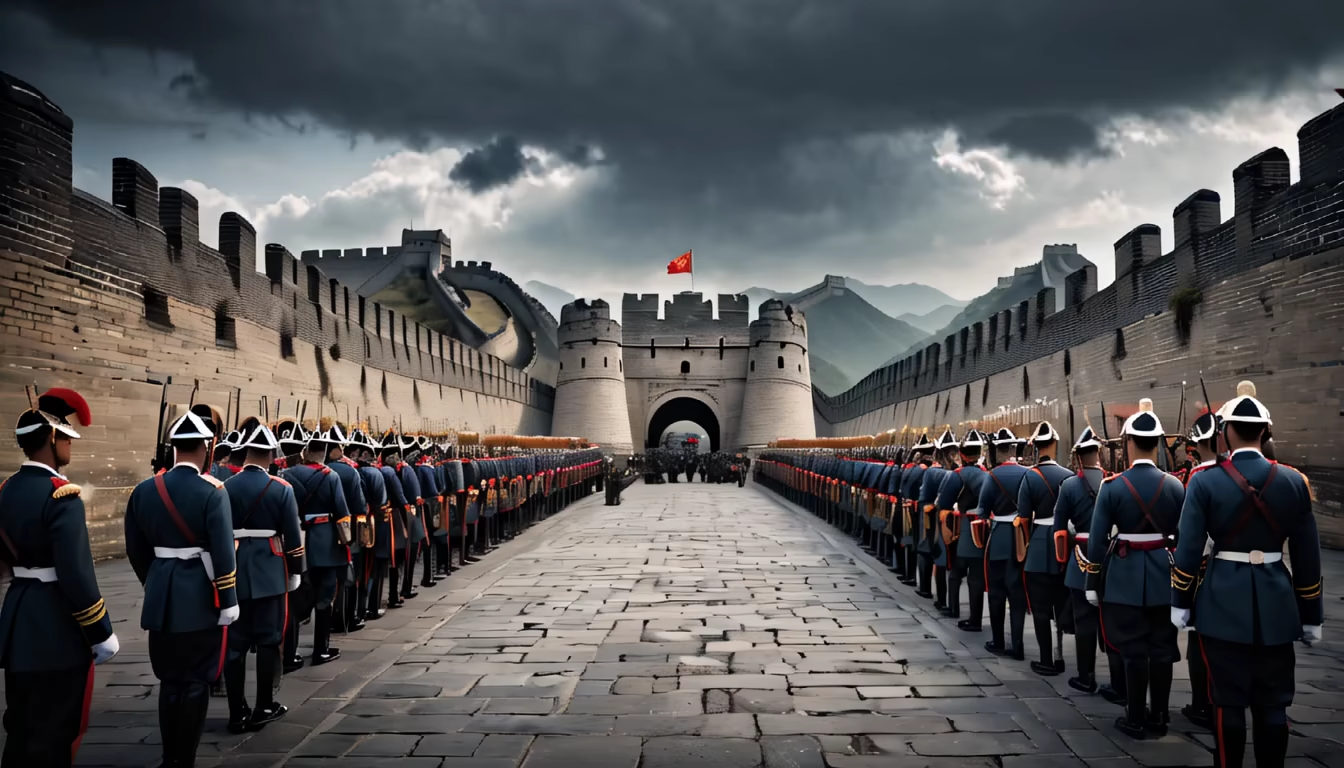

Prompt: Imagine an image split into two sections: one side depicting British ships on the waters near China, showcasing the naval strength and presence of the British Empire. On the other side, portray a representation of China, perhaps the coastline or iconic landmarks, depicting the country's sovereignty and historical significance.In the center, illustrate a brewing storm or intense atmosphere, symbolizing the escalating tensions between the two sides. Visual cues such as ships positioned for conflict or flags representing the nations involved can emphasize the building confrontation. This image aims to capture the pivotal moment in 1839 when escalating tensions culminated in the outbreak of the First Opium War, set against the backdrop of formidable naval forces and a historical clash of interests.
Style: Photographic
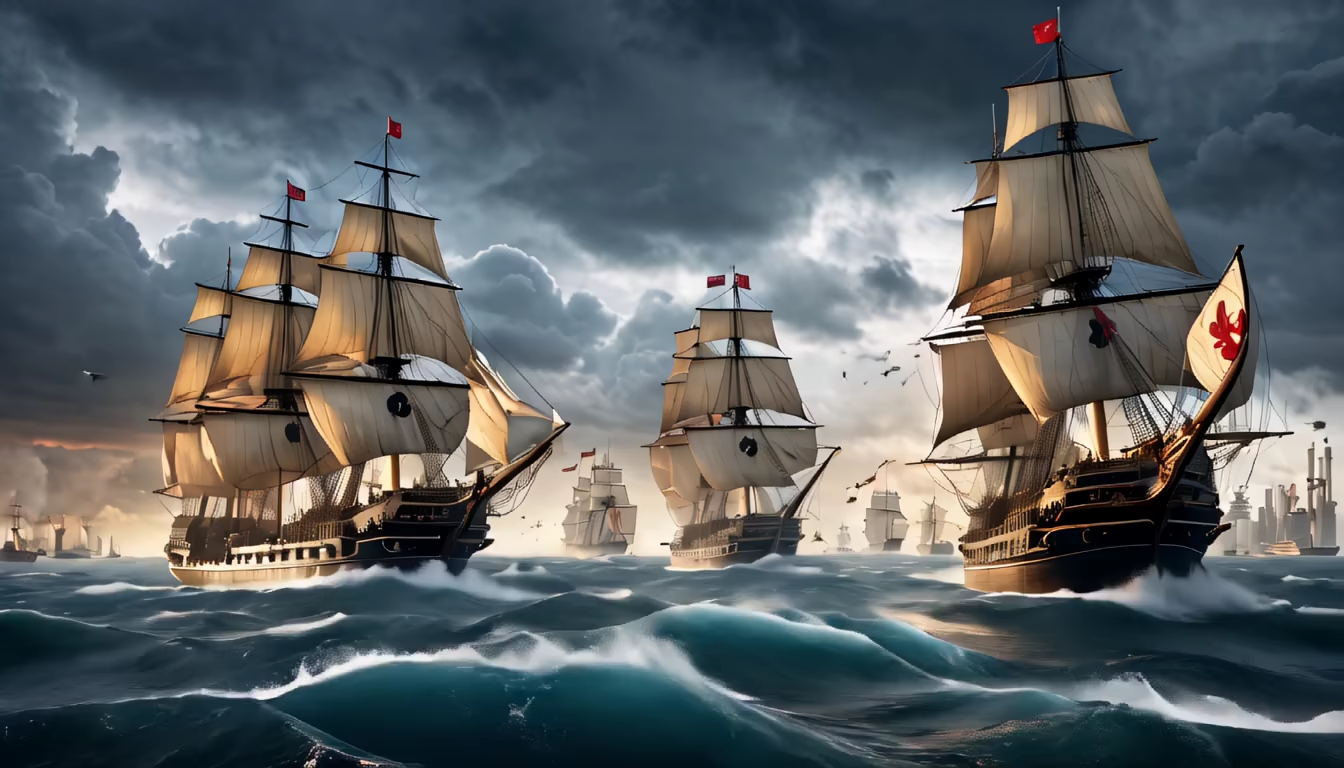

Prompt: Visualize an image split into two parts: on one side, depict British merchants or ships trading opium, surrounded by wealth and prosperity symbols like coins or opulent items. On the other side, portray the Chinese government or officials struggling to contain the opium trade, trying to stop the flow of the drug into their country, perhaps through the confiscation or destruction of opium crates.In the middle, create a visual representation of tension and conflict, symbolized by opposing forces or barriers between the two sides. This image aims to illustrate the fundamental cause of the conflict—the profitable opium trade for the British contrasted with the Chinese efforts to suppress it, emphasizing the stark differences in interests that led to the escalation of tensions and ultimately the conflict between the two nations.
Style: Photographic


Prompt: Showcasing three distinct scenes - Tamao, Chuanbi, and Bogue - each with British naval ships dominating the waters. Highlight the British fleet's overwhelming firepower and strategic positioning, exerting control over crucial waterways. The scene depicts the impact on Chinese trade routes and military, portraying the pressure and consequences of British naval dominance during these historic battles.
Style: Photographic

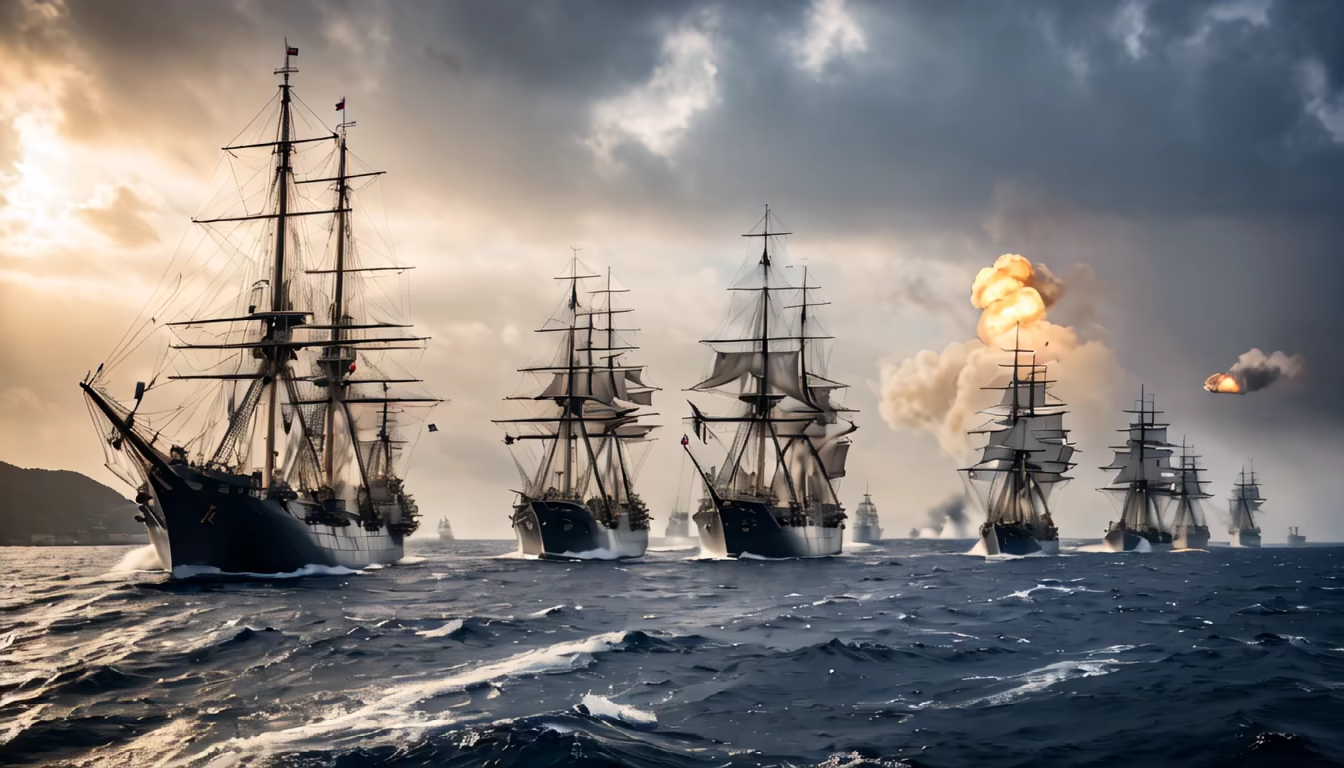
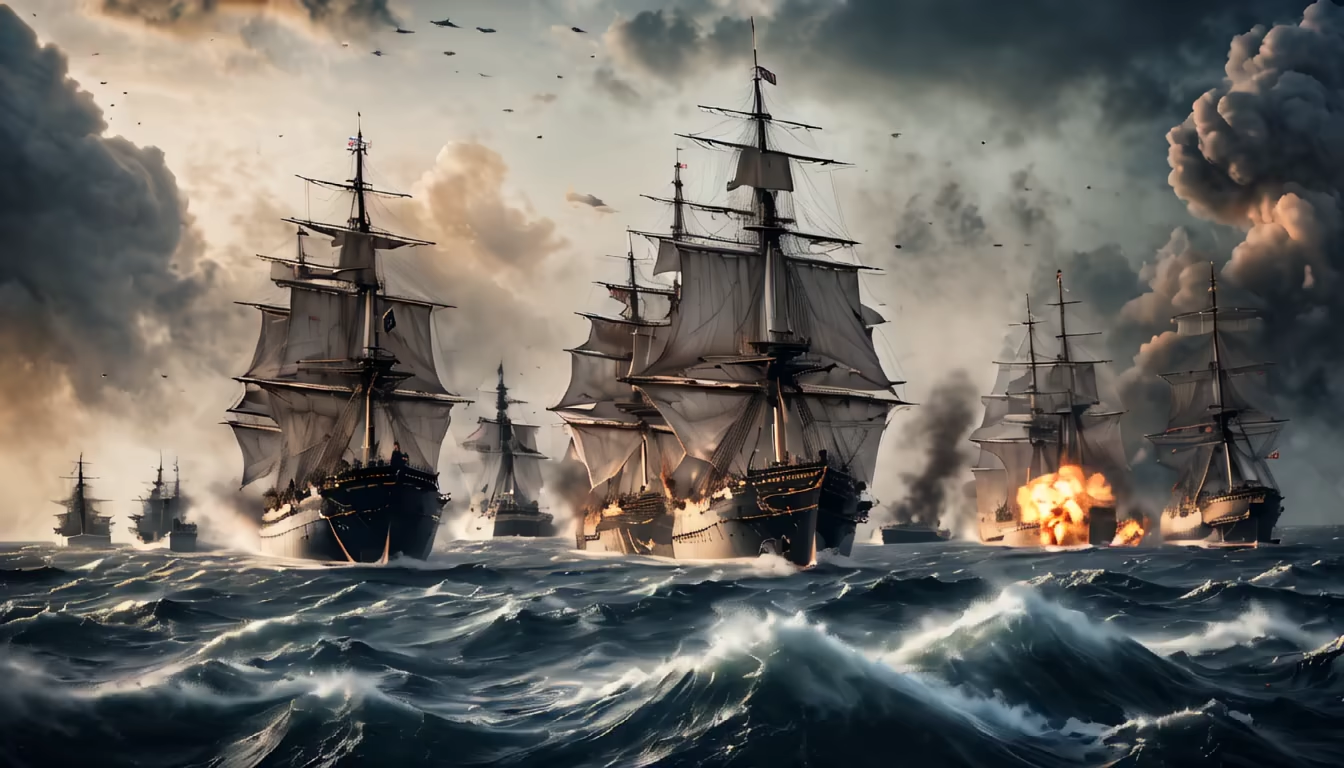
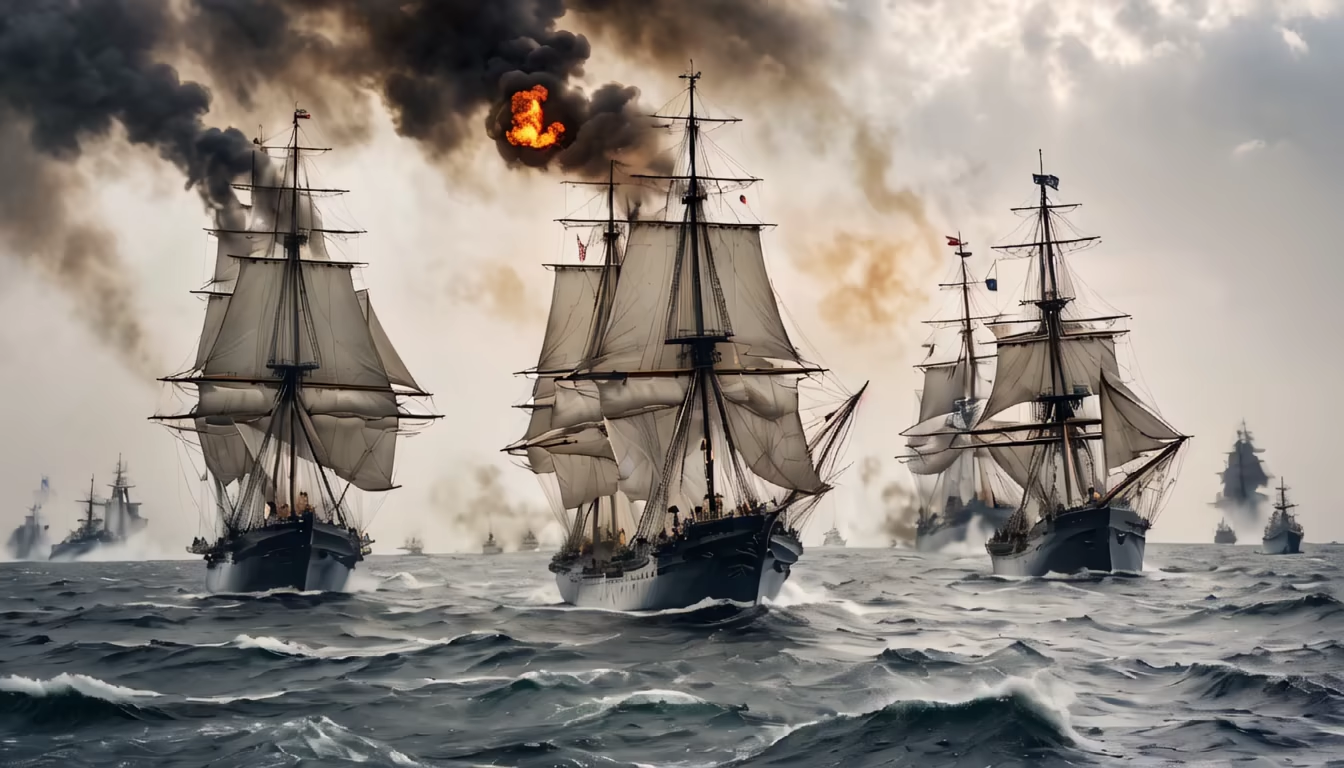
Prompt: How about an image showing a historical trade scenario between China and Britain? It could feature Chinese goods like tea, silk, and porcelain being loaded onto ships headed to Britain, while British goods or representatives struggle to gain entry into China, illustrating the one-sided nature of the trade relationship. This could be depicted through contrasting scenes or visuals to highlight the unequal exchange.
Style: Photographic


Prompt: The image presents a stark contrast between the technological prowess of the British navy and the traditional Chinese naval vessels in a dramatic naval battle setting. On one side of the scene, towering and formidable British steam-powered gunboats dominate the waters. These sleek and modern vessels are equipped with advanced artillery and steam-powered engines, emitting plumes of smoke as they advance with precision. On the opposing side, traditional Chinese junks, adorned with vibrant colors and intricate designs, sail valiantly. However, they appear antiquated and comparatively smaller, relying on sails and oars for propulsion. Their cannons, though strategically positioned, pale in comparison to the firepower of the British warships. The waters are turbulent, reflecting the intensity of the conflict. Smoke billows from cannon fire, creating a haze that shrouds the vessels engaged in the confrontation. The scene captures the disparity in technology and firepower between the British steam-powered gunboats and the traditional Chinese junks, illustrating the clash between modern innovation and traditional naval strategies during this historical period of the Opium Wars.
Style: Photographic
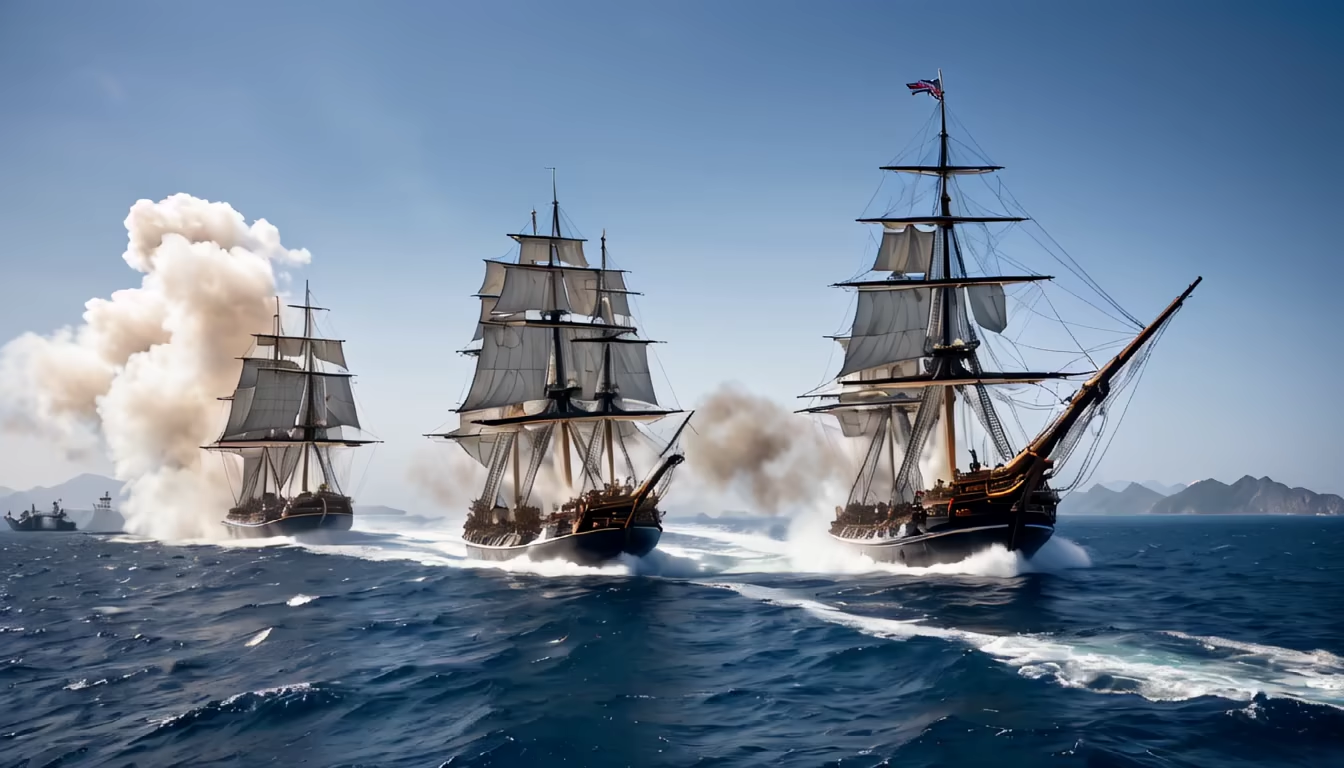
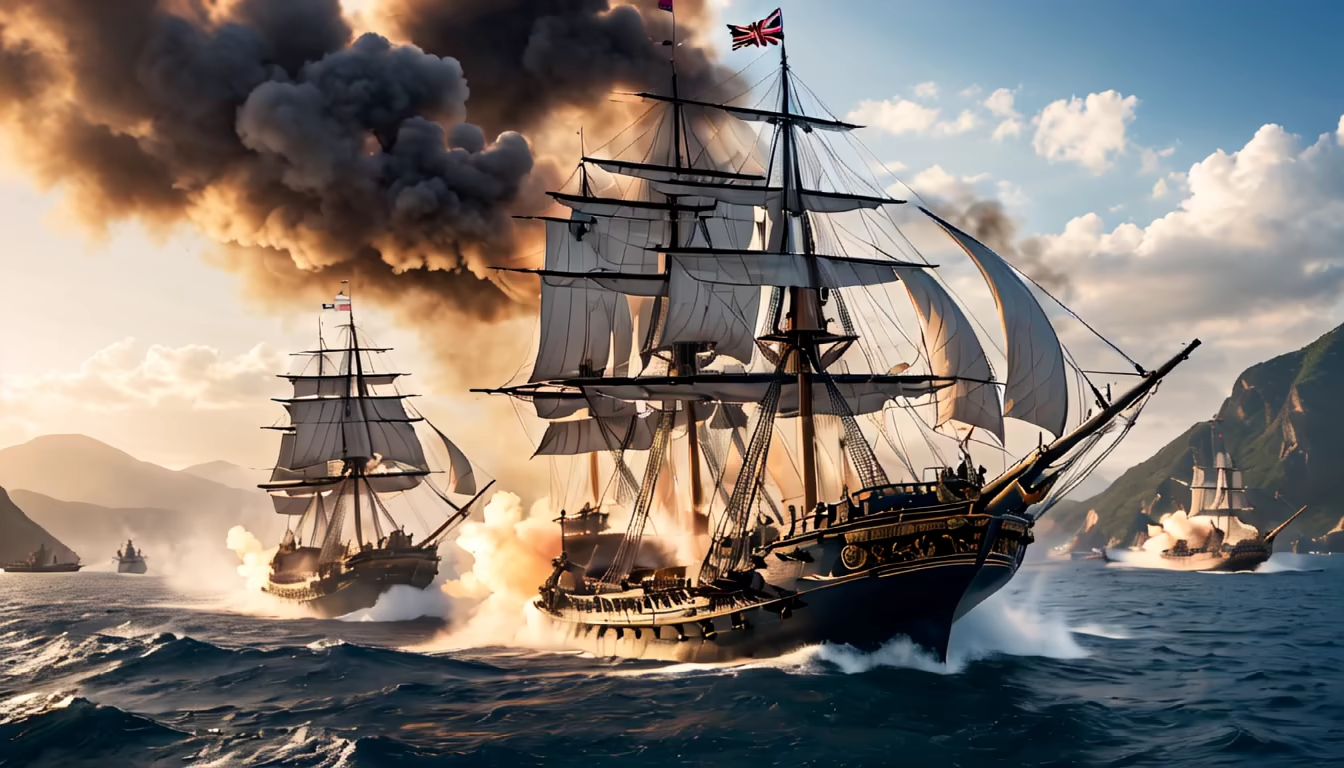
Prompt: Visualize an image split into two contrasting scenes: one side depicting the British interests in China, possibly through merchants, ships, or symbols of trade, showcasing their economic endeavors. On the other side, portray Commissioner Lin Zexu overseeing the dramatic destruction of opium crates, exuding determination and authority.In the center, create a dynamic visual of the opium being seized and destroyed, symbolizing the audacious move made by Lin Zexu. Show reactions from both sides – the British representatives displaying shock or agitation, while Lin Zexu remains resolute. This image aims to capture the boldness of Lin Zexu's actions, highlighting the direct challenge it posed to British interests in China, setting the stage for escalating tensions and conflict.
Style: Photographic


Prompt: An evocative visual portrays a dramatic maritime scene from the historical period of the Opium Wars. The image encapsulates the intensity of naval warfare during this time, showcasing a fierce confrontation between British and Chinese naval forces on the open sea. The foreground exhibits the tumultuous waters, roiled by the clash of warships, their sails taut against the wind. British war vessels, sleek and sturdy, engage in a strategic formation, cannons protruding from their sides, billowing smoke and fire as they exchange volleys with Chinese junks, adorned with colorful sails and intricate designs. The horizon is dominated by the vast expanse of the sea, with the sky painted in hues of orange and red from the setting sun, casting a fiery glow on the tumultuous scene. In the distance, the silhouettes of more ships approach, indicating the ongoing nature of the conflict and the continuous struggle for naval dominance. This image encapsulates the pivotal battles fought at sea during the Opium Wars, showcasing the high-stakes confrontations, technological disparities, and the crucial role of naval power in shaping the outcome of the conflicts between the British and Chinese forces.
Style: Photographic
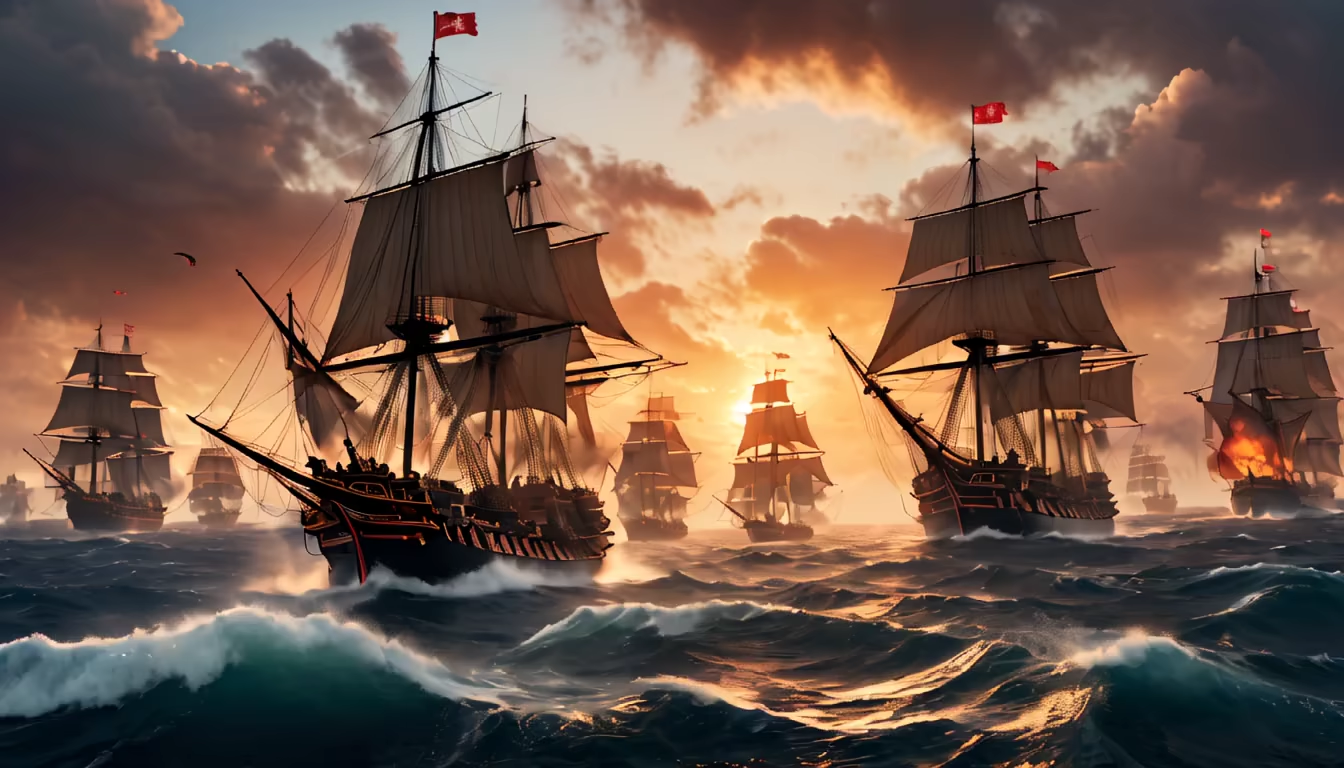

Prompt: Imagine a series of sequential illustrations showcasing the progression of the battles. Begin with an imposing British naval fleet dominating the waters, cannons firing and ships advancing, while smaller, outdated Chinese vessels struggle in the background. The subsequent images could depict key moments of the battles at Tamao, Chuanbi, and Bogue, highlighting the British fleet's overwhelming firepower and strategic maneuvers that led to their control over the waterways. Show the Chinese ships attempting to resist but ultimately being outmatched, symbolizing the technological and strategic disparity between the two forces.
Style: Cinematic
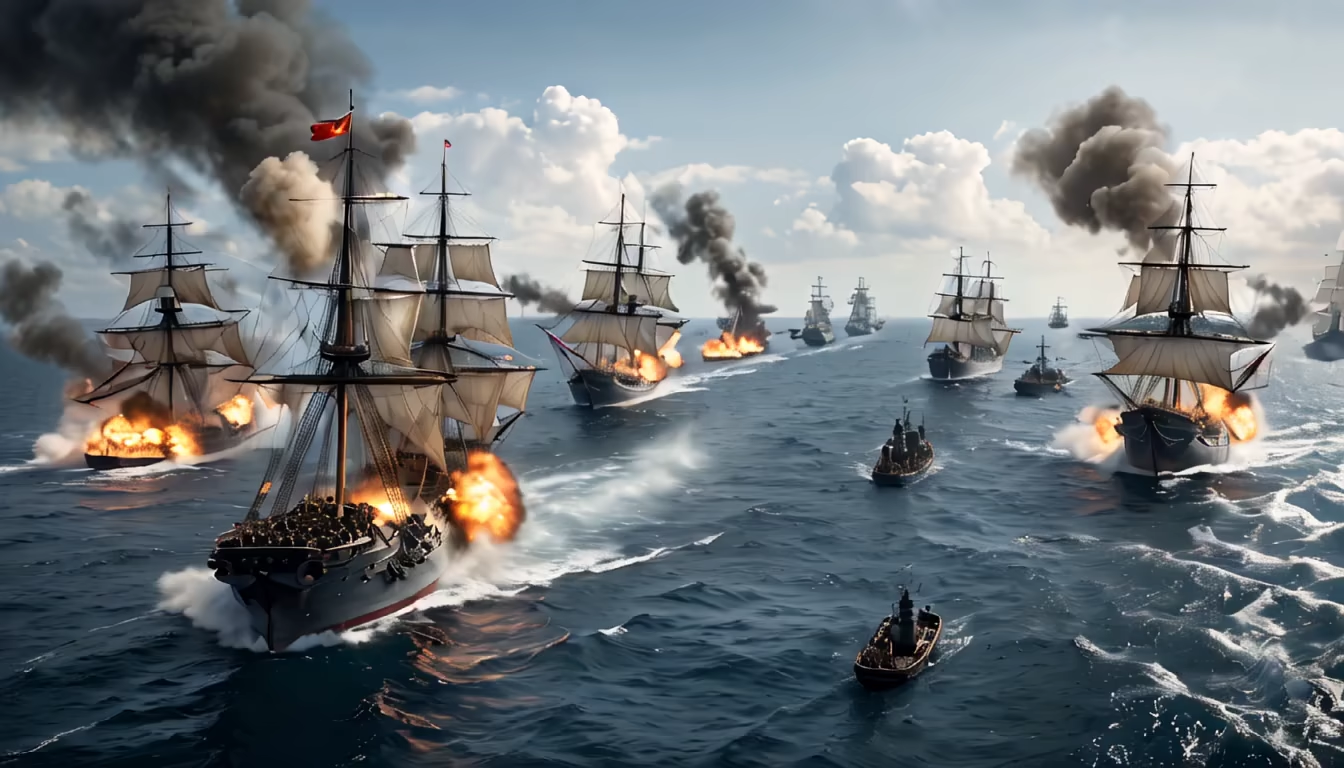

Prompt: The image depicts a stark contrast between two opposing forces. On one side, there are numerous British warships dominating the scene, portrayed in vivid detail with billowing sails and advanced cannonry. These ships are positioned aggressively, indicating their imposing presence on the water. In contrast, the Chinese forces are represented in the background, significantly outnumbered and outmatched. Their ships, fewer in number and visibly less advanced, appear overwhelmed and scattered amidst the turmoil of battle. Smoke rises from their vessels, suggesting the chaos and helplessness they faced against the powerful British naval onslaught. The disparity in military strength is emphasized, portraying the overwhelming might of the British forces and the defensive plight of the Chinese, who are depicted as valiant but ultimately outgunned. The image aims to capture the unequal and daunting nature of the conflict, highlighting the vulnerability of the Chinese forces against the relentless British offensive during the First Opium War.
Style: Photographic
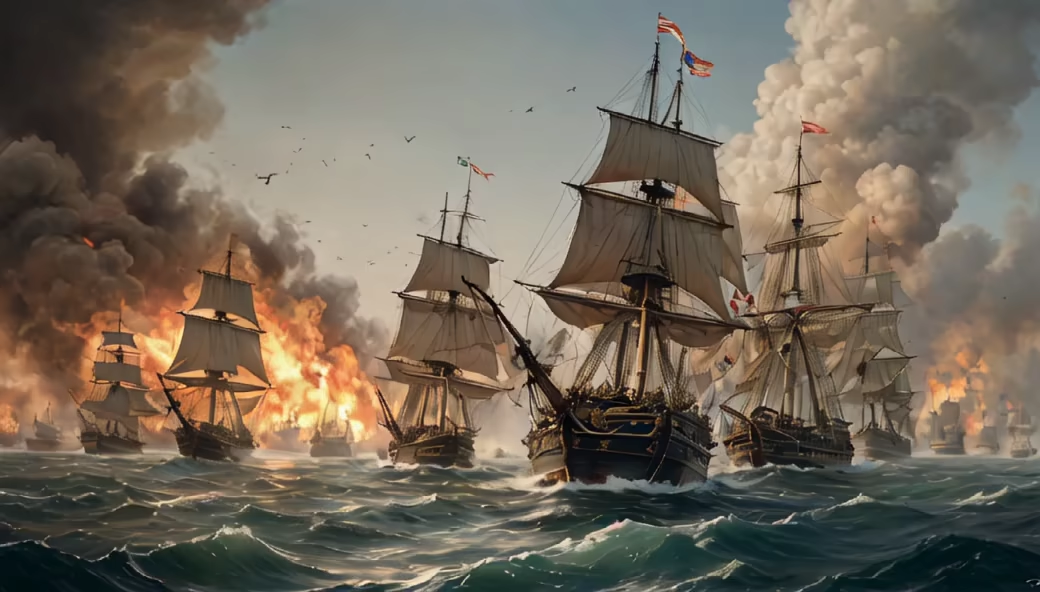
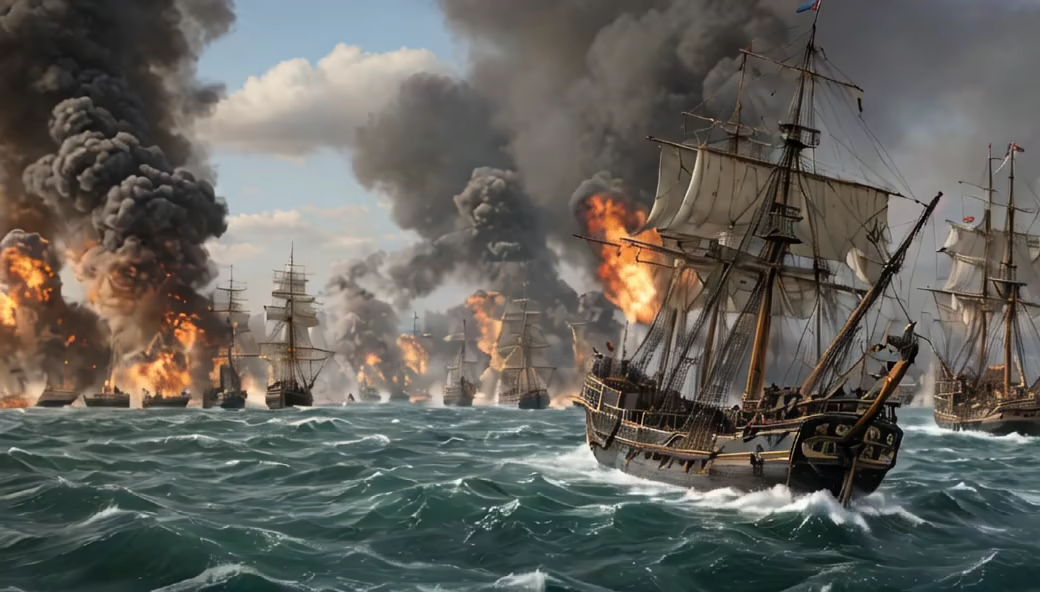
Prompt: Picture an image split into two scenes: one portraying the struggle of British merchants attempting to trade their goods in China, facing barriers and restrictions. The other side could depict a depiction of opium being traded by British merchants to Chinese traders, highlighting the solution Britain found to address their trade imbalance. You might show ships arriving with crates of opium contrasted with the difficulty British traders faced with their own goods. The visual contrast can emphasize the role of opium as a solution for Britain's trade predicament.
Style: Cinematic

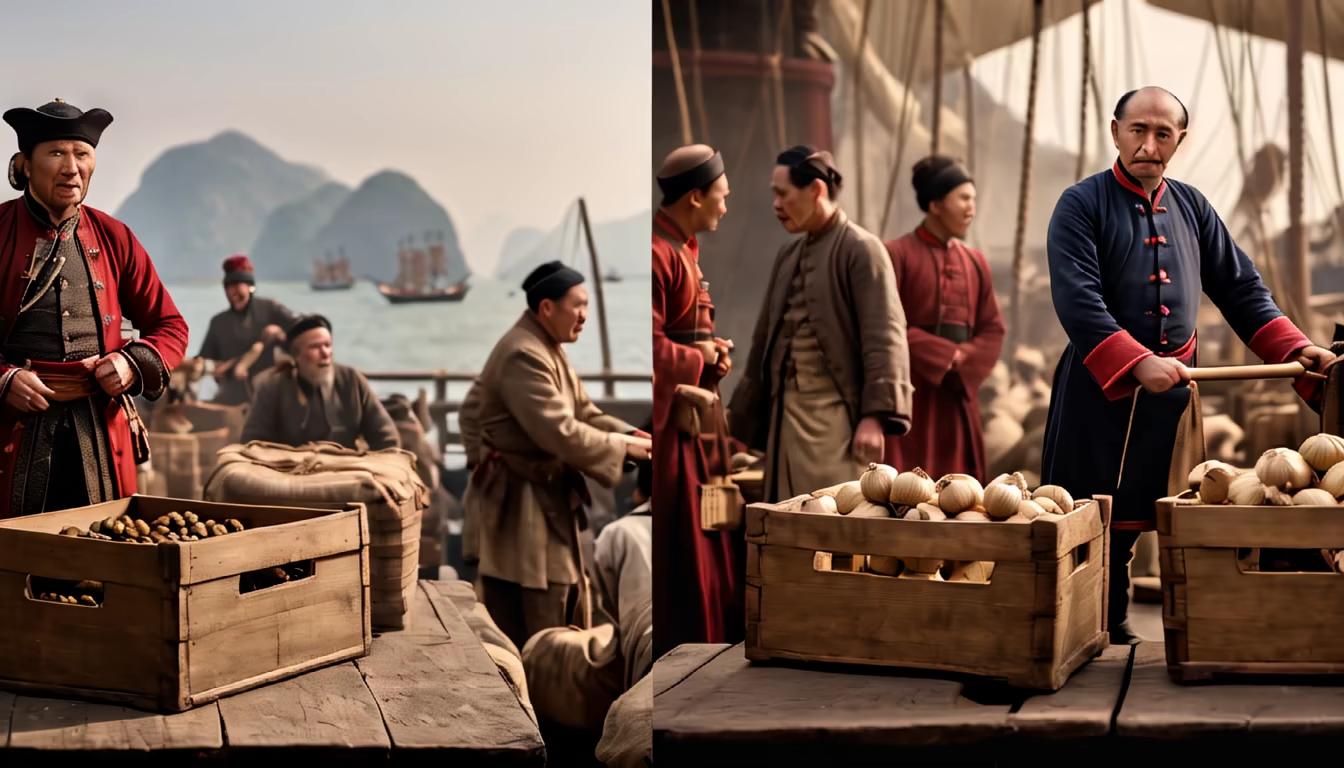
Prompt: The image portrays a series of pivotal naval battles during the Opium Wars, highlighting the overwhelming display of British naval power and the intensity of the conflicts. In the foreground, a British naval squadron takes center stage, their warships positioned with precision in battle formation. These imposing vessels, marked with the Union Jack, loom large over the waters, emitting billows of smoke and fire from their cannons. In contrast, Chinese junks and naval vessels, depicted in the background, attempt to resist the formidable British onslaught. The Chinese ships, although numerous, appear outnumbered and outmatched, struggling against the relentless barrage of firepower from the British fleet. The tumultuous sea is the focal point, churned by the exchange of cannon fire and the chaos of battle. The sky overhead is overcast, mirroring the tension and gravity of the confrontations at Tamao, Chuanbi, and Bogue. This vivid depiction captures the decisive moments of these historic battles, illustrating the overwhelming dominance of the British forces in terms of naval firepower and strategy, shaping the outcome of the conflicts during the Opium Wars.
Style: Photographic


Prompt: Imagine an image split into two parts: one side depicting a vibrant, bustling scene in China with various coveted goods like tea, silk, and porcelain being traded and displayed. On the other side, portray a less dynamic scene in Britain, showcasing a limited display of British goods struggling to gain entry into China. Overlaying these scenes, visualize a bridge formed by opium, connecting the two sides. On the British side, ships loaded with crates of opium arrive, while on the Chinese side, depict the consumption and trade of opium becoming prominent, symbolizing Britain's solution to address the trade imbalance. This contrast visually illustrates how opium became the link between the desires of Britain and the previously unattainable Chinese market.
Style: Cinematic

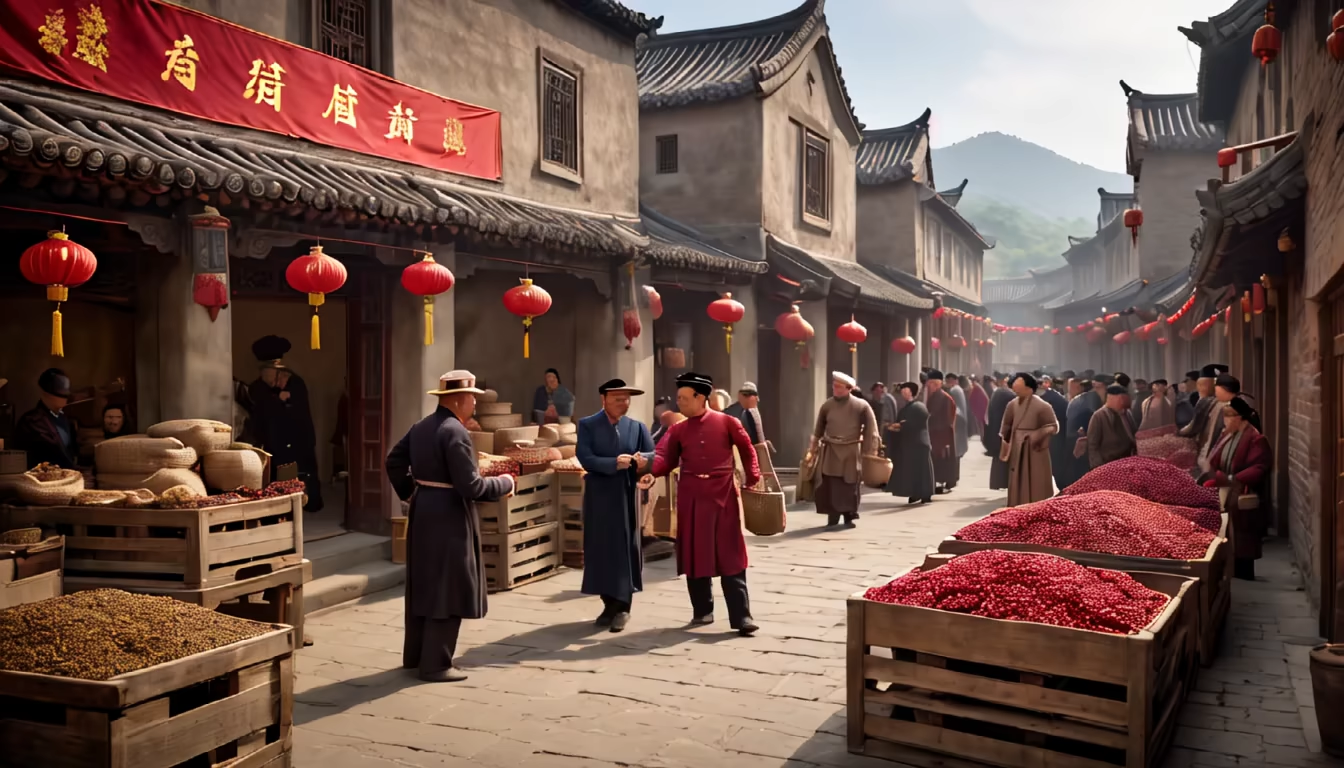
Prompt: How about an image depicting British ships navigating through a strategic waterway, while Chinese ships struggle or are blocked from accessing it? This could represent the British gaining control over the crucial trade routes and harbors, showcasing the imbalance of power and its impact on China's trade and military.
Style: Photographic
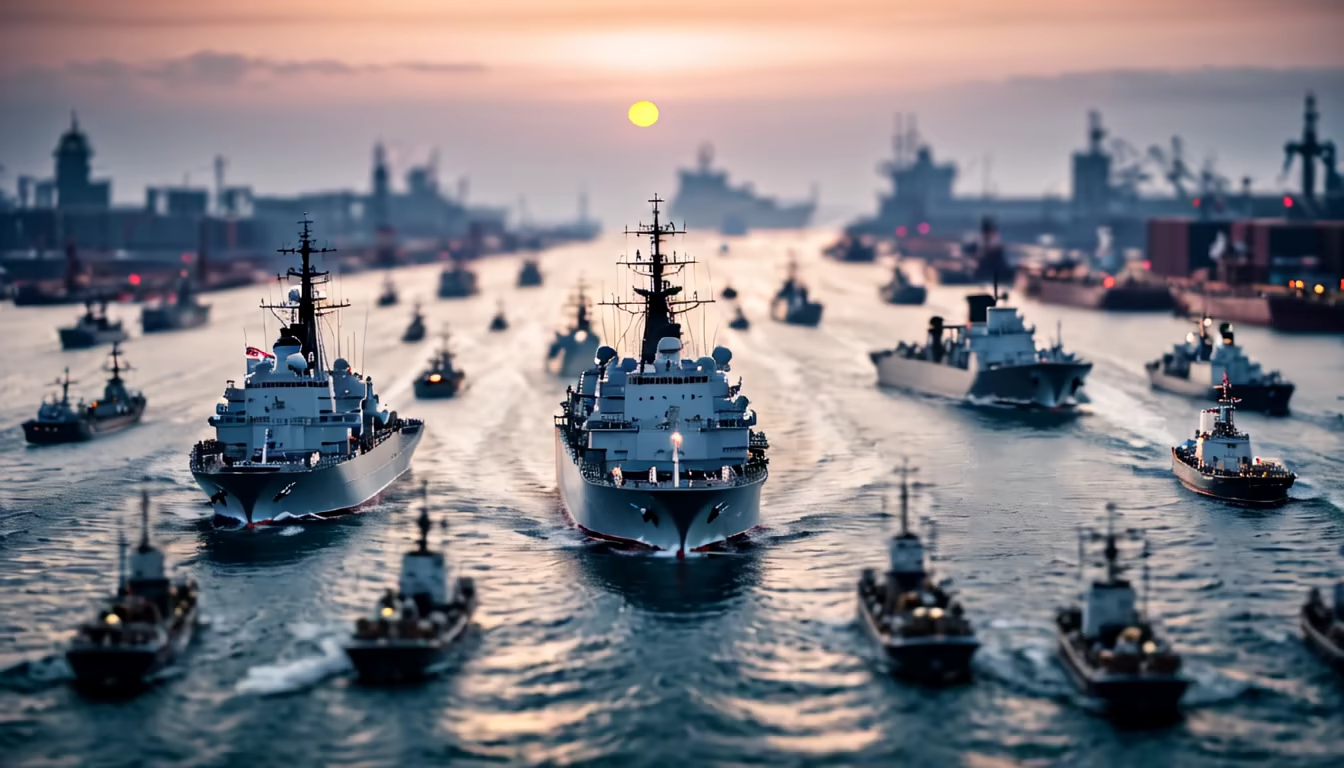
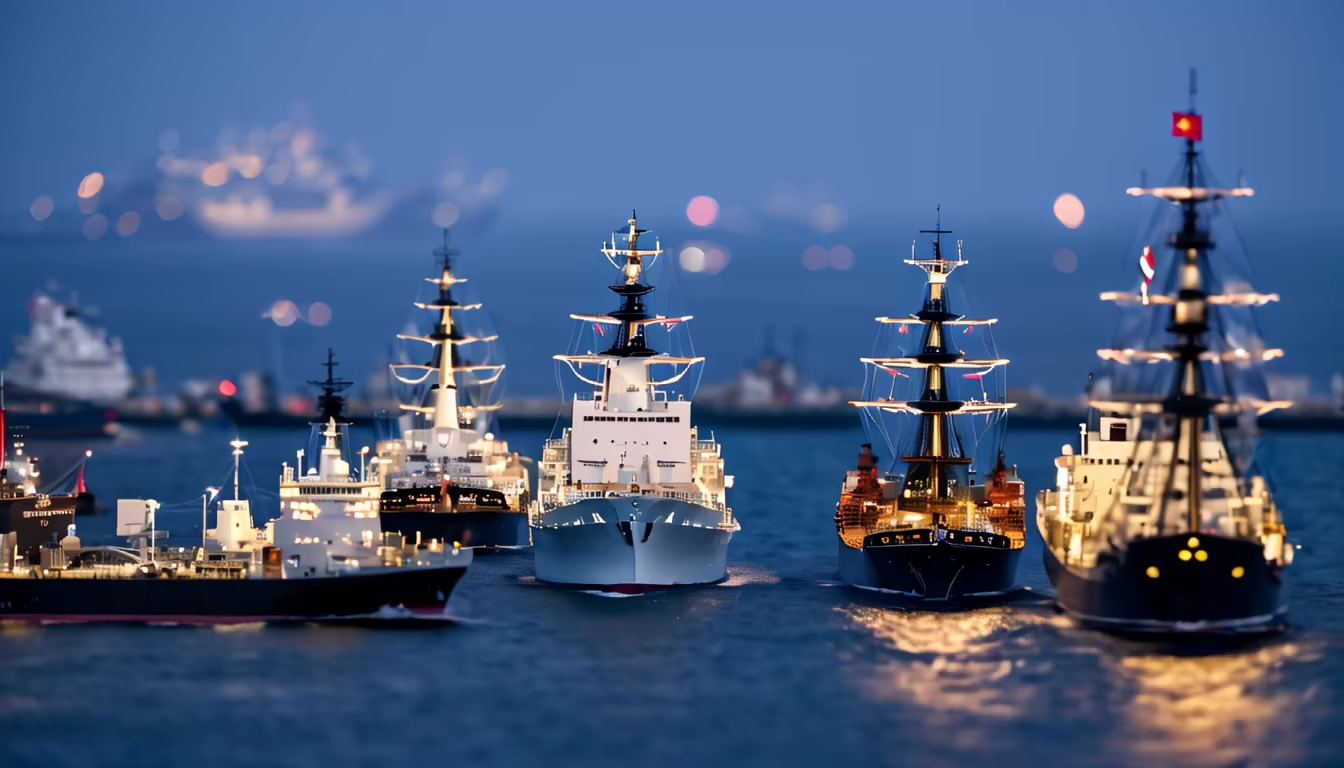
Prompt: The image presents a stark contrast between the technological prowess of the British navy and the traditional Chinese naval vessels in a dramatic naval battle setting. On one side of the scene, towering and formidable British steam-powered gunboats dominate the waters. These sleek and modern vessels are equipped with advanced artillery and steam-powered engines, emitting plumes of smoke as they advance with precision. On the opposing side, traditional Chinese junks, adorned with vibrant colors and intricate designs, sail valiantly. However, they appear antiquated and comparatively smaller, relying on sails and oars for propulsion. Their cannons, though strategically positioned, pale in comparison to the firepower of the British warships. The waters are turbulent, reflecting the intensity of the conflict. Smoke billows from cannon fire, creating a haze that shrouds the vessels engaged in the confrontation. The scene captures the disparity in technology and firepower between the British steam-powered gunboats and the traditional Chinese junks, illustrating the clash between modern innovation and traditional naval strategies during this historical period of the Opium Wars.
Style: Cinematic

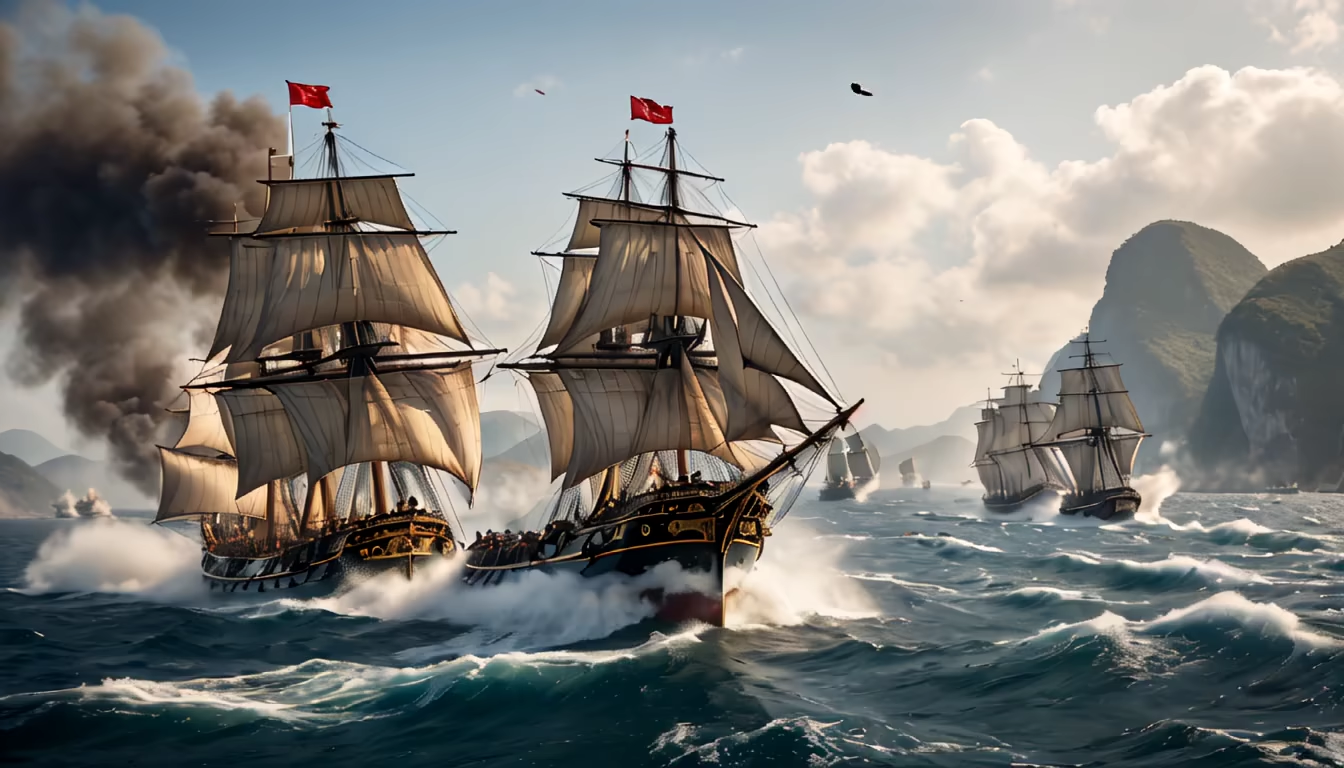
Prompt: Imagine an image split into two halves: one side showcasing the Chinese government's efforts to ban the opium trade, with officials destroying opium stocks and implementing anti-opium measures. This could be depicted through scenes of crackdowns on opium dens or the destruction of confiscated opium. On the other side, illustrate the intended outcome, with visuals representing a more stable and balanced society, healthier individuals, and a symbolic portrayal of restored trade equilibrium. The image would aim to highlight the proactive steps taken by the Chinese government to safeguard their population and restore order amid the opium crisis.
Style: Photographic
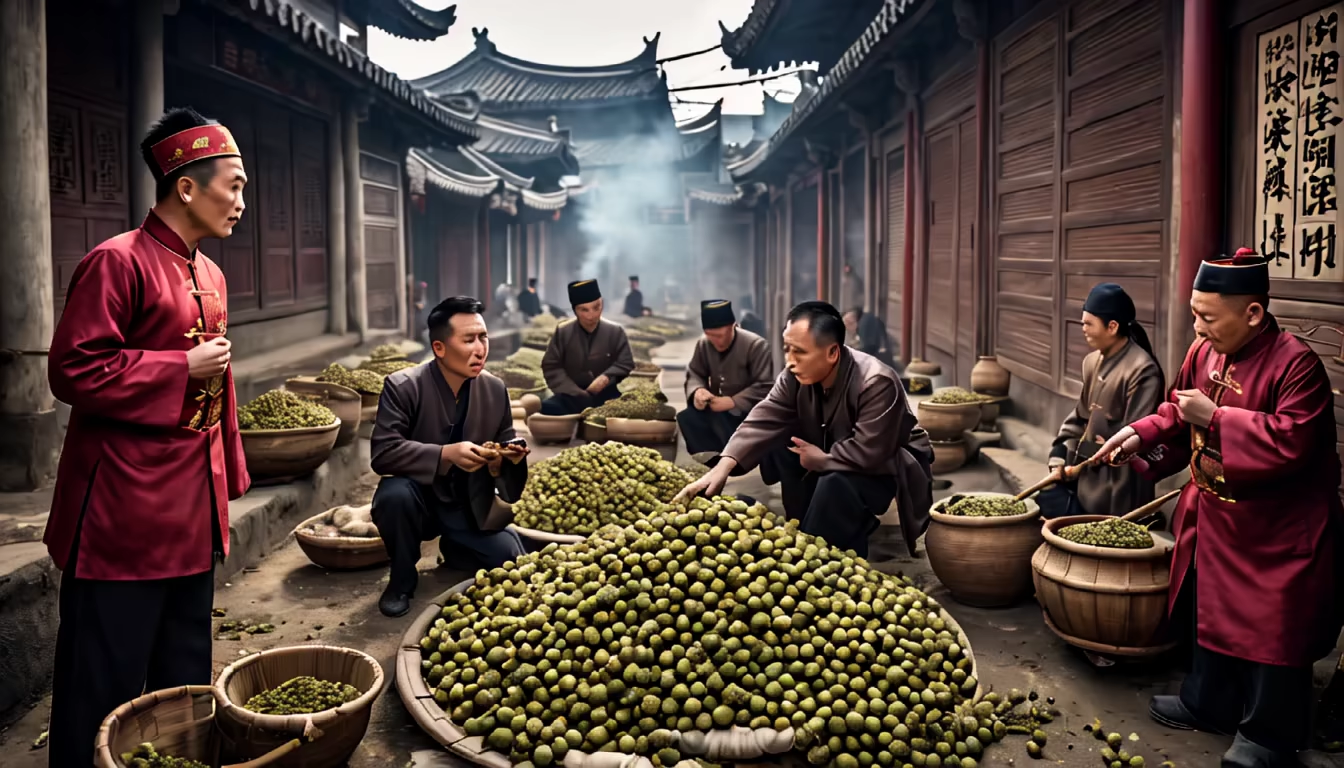

Prompt: Imagine a scene depicting British naval ships surrounding the island of Hong Kong, showcasing their dominance over the strategic location. You could include British flags, ships at sea, and the silhouette of Hong Kong Island in the background to portray the historical moment of British control over the territory.This should be during the opium war period .
Style: Photographic
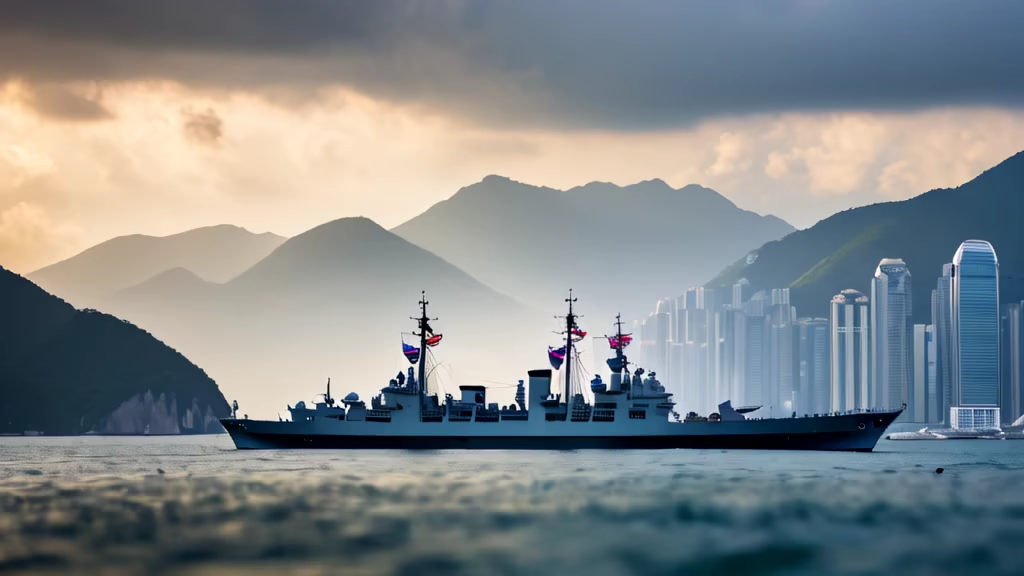
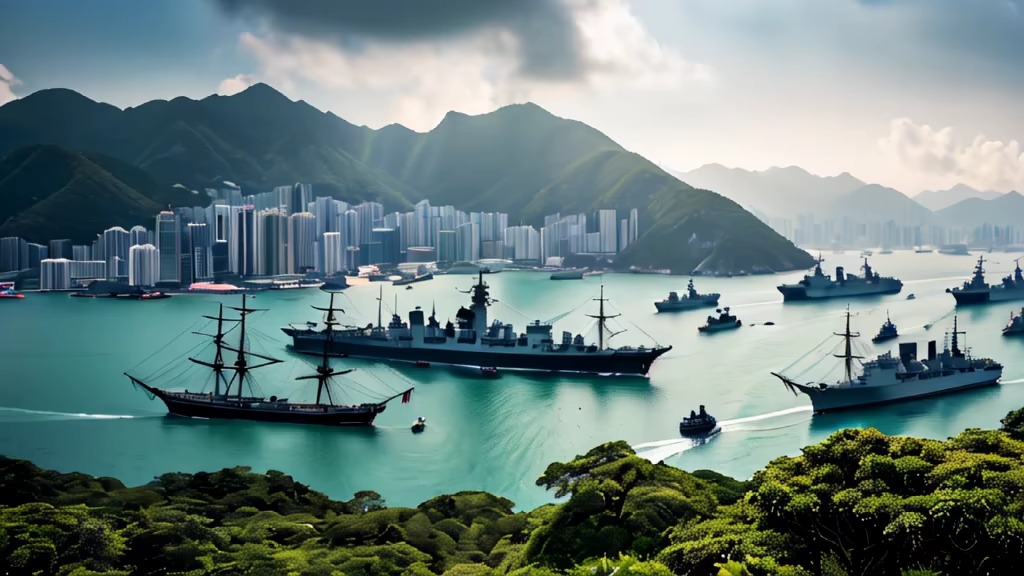
Prompt: Visualize an image split into two contrasting scenes: on one side, portray the Chinese government's crackdown on the opium trade, with officials and workers destroying crates of opium, while on the other side, depict a stern and displeased British envoy or representatives reacting to this interference. Show their dissatisfaction or anger through body language or facial expressions, symbolizing Britain's resistance to China's attempts to disrupt their profitable opium trade. This contrast aims to emphasize Britain's displeasure and resistance towards the Chinese interference in their lucrative trade.
Style: Photographic
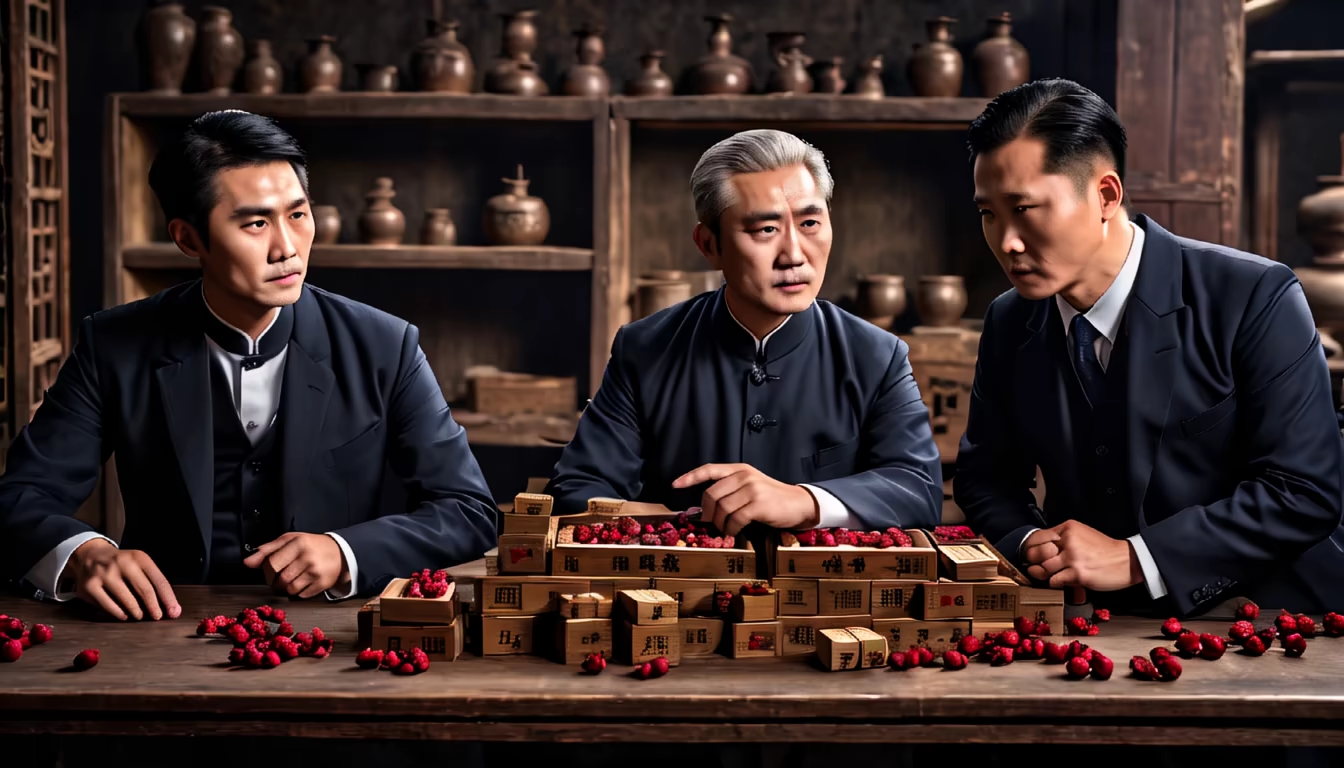
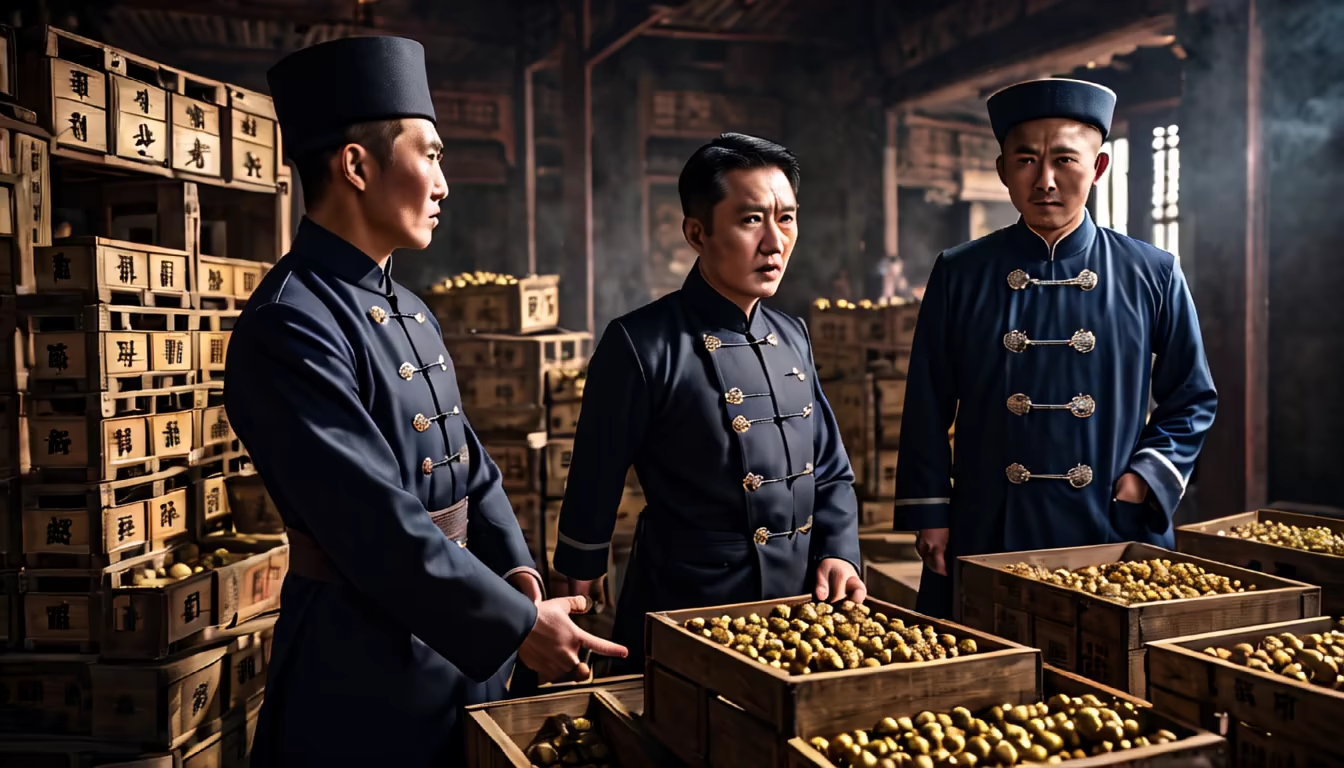
Prompt: How about an image showing a historical trade scenario between China and Britain? It could feature Chinese goods like tea, silk, and porcelain being loaded onto ships headed to Britain, while British goods or representatives struggle to gain entry into China, illustrating the one-sided nature of the trade relationship. This could be depicted through contrasting scenes or visuals to highlight the unequal exchange.
Style: Cinematic


Prompt: An evocative visual portrays a dramatic maritime scene from the historical period of the Opium Wars. The image encapsulates the intensity of naval warfare during this time, showcasing a fierce confrontation between British and Chinese naval forces on the open sea. The foreground exhibits the tumultuous waters, roiled by the clash of warships, their sails taut against the wind. British war vessels, sleek and sturdy, engage in a strategic formation, cannons protruding from their sides, billowing smoke and fire as they exchange volleys with Chinese junks, adorned with colorful sails and intricate designs. The horizon is dominated by the vast expanse of the sea, with the sky painted in hues of orange and red from the setting sun, casting a fiery glow on the tumultuous scene. In the distance, the silhouettes of more ships approach, indicating the ongoing nature of the conflict and the continuous struggle for naval dominance. This image encapsulates the pivotal battles fought at sea during the Opium Wars, showcasing the high-stakes confrontations, technological disparities, and the crucial role of naval power in shaping the outcome of the conflicts between the British and Chinese forces.
Style: Cinematic
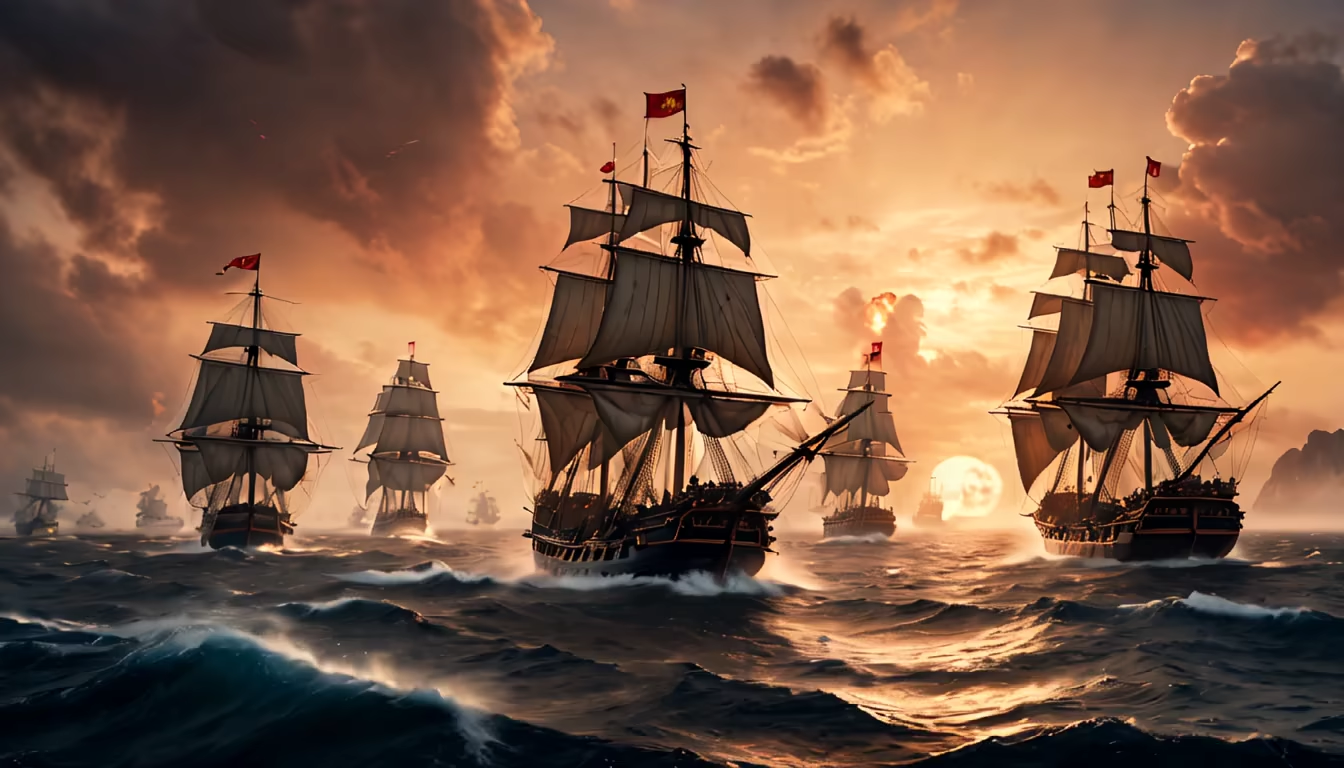
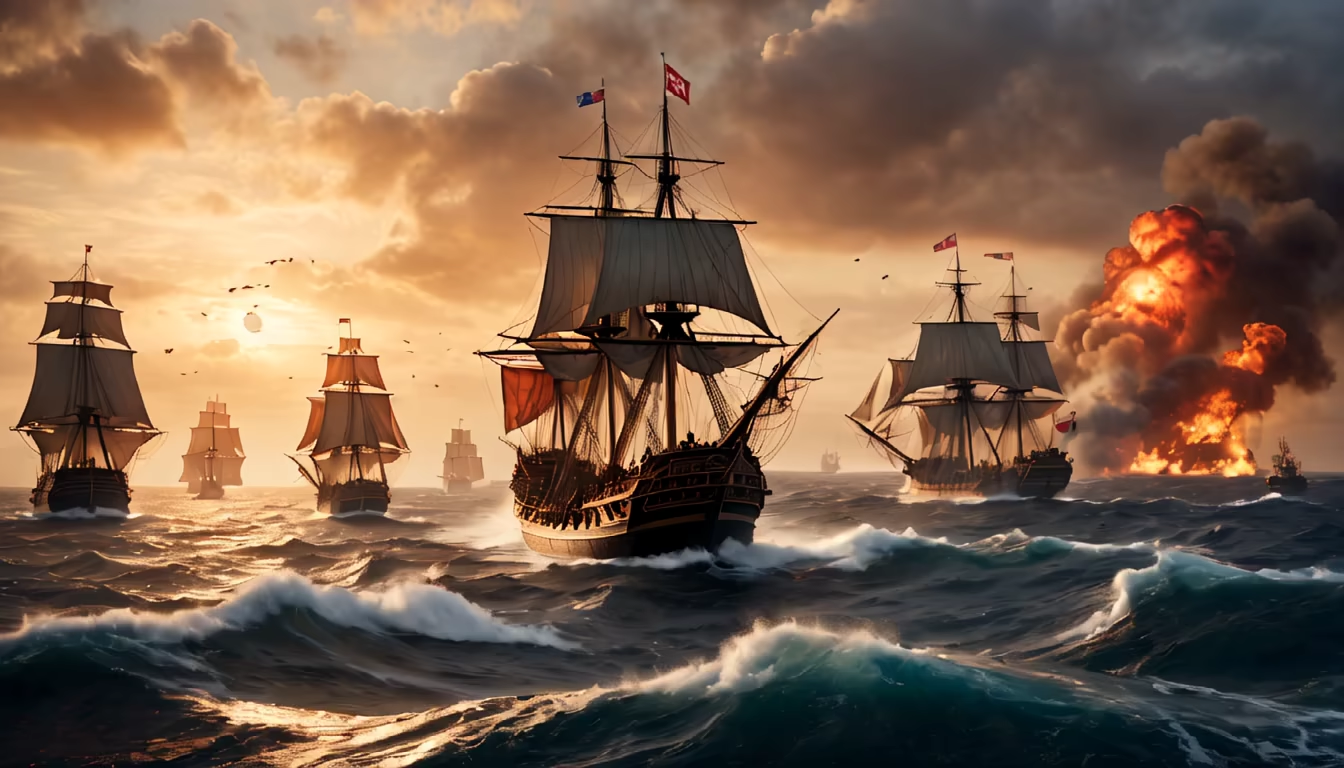
Prompt: Imagine an image split into two parts. On one side, portray the devastating effects of the opium epidemic in China: scenes of suffering individuals, hospitals overwhelmed, and communities in distress due to addiction and health issues caused by opium abuse. On the other side, depict a visual representation of China's trade deficit during the Opium War, showcasing the outflow of silver and wealth from China to Britain due to the opium trade. The image could juxtapose these elements, highlighting the dual impact of a public health crisis and economic turmoil during this historical period.
Style: Photographic
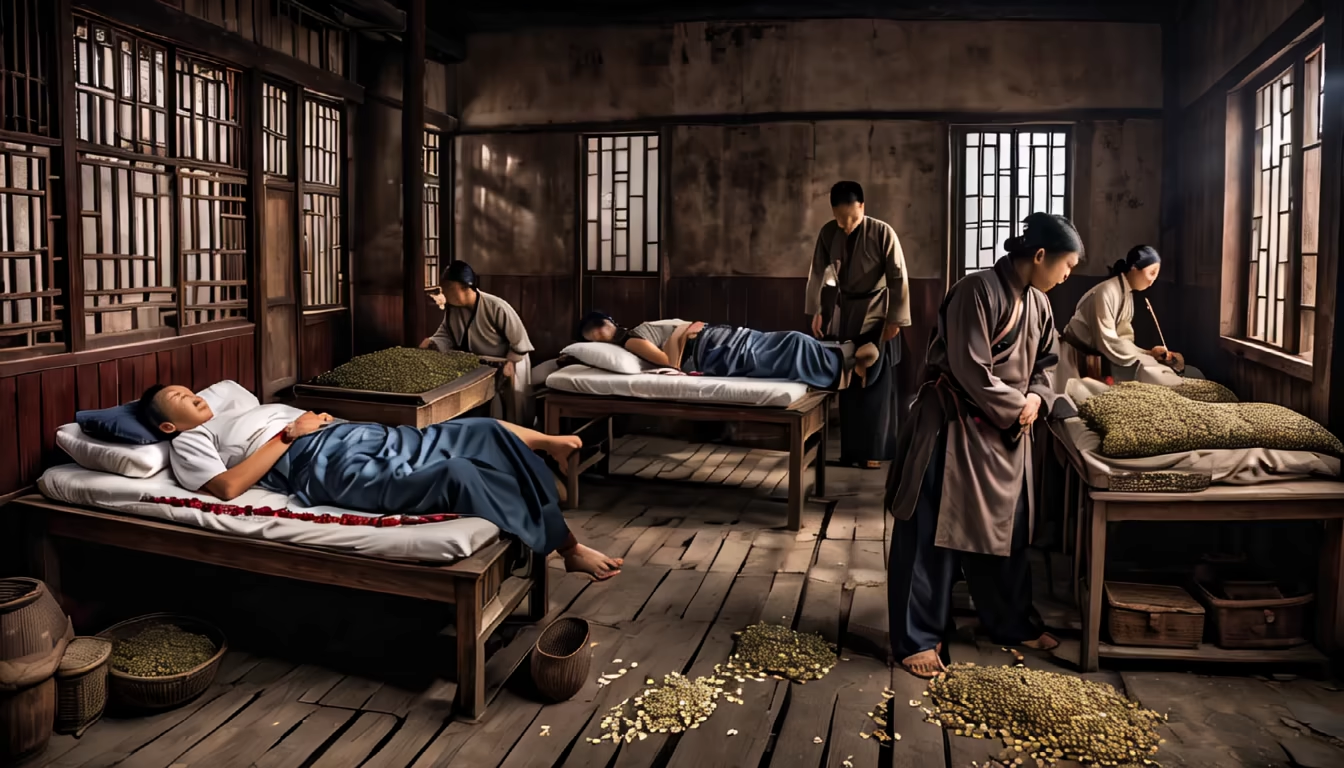
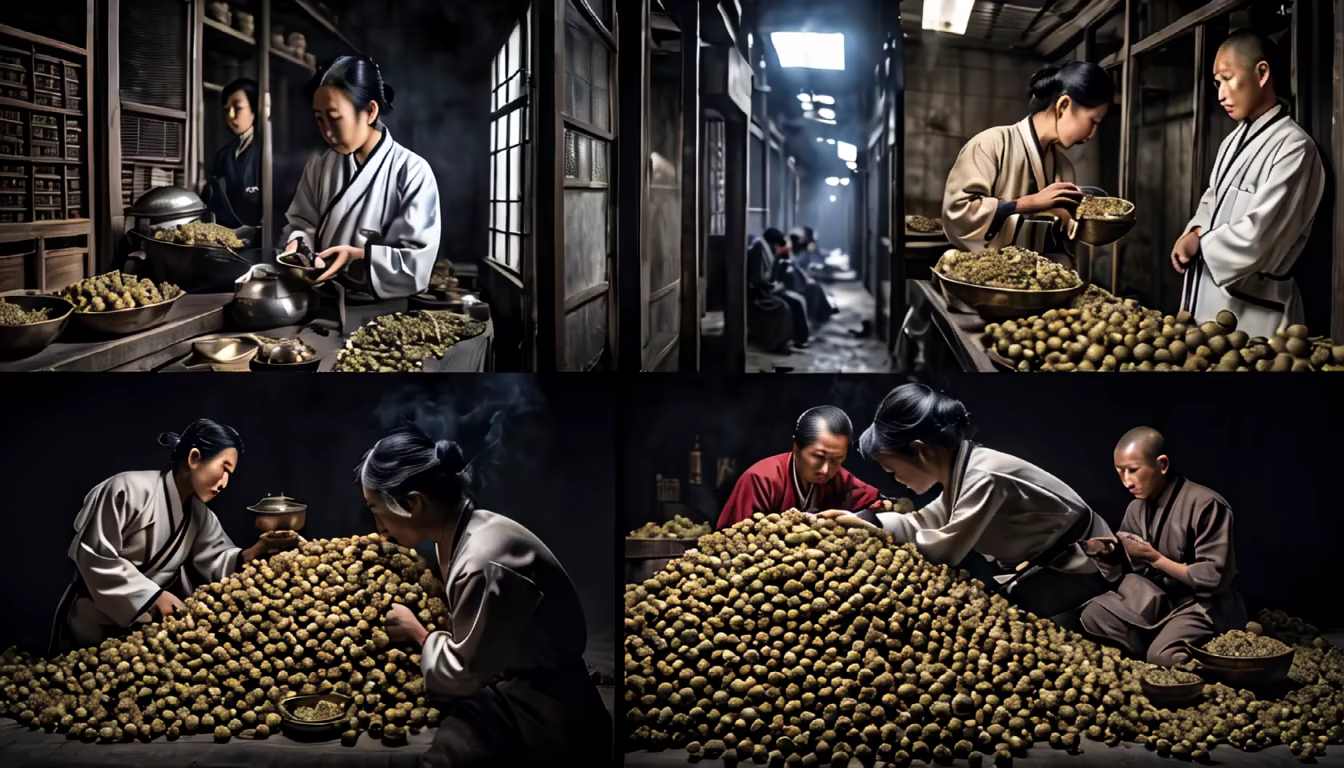
Prompt: Imagine an image split into two parts. On one side, portray the devastating effects of the opium epidemic in China: scenes of suffering individuals, hospitals overwhelmed, and communities in distress due to addiction and health issues caused by opium abuse. On the other side, depict a visual representation of China's trade deficit during the Opium War, showcasing the outflow of silver and wealth from China to Britain due to the opium trade. The image could juxtapose these elements, highlighting the dual impact of a public health crisis and economic turmoil during this historical period.
Style: Photographic
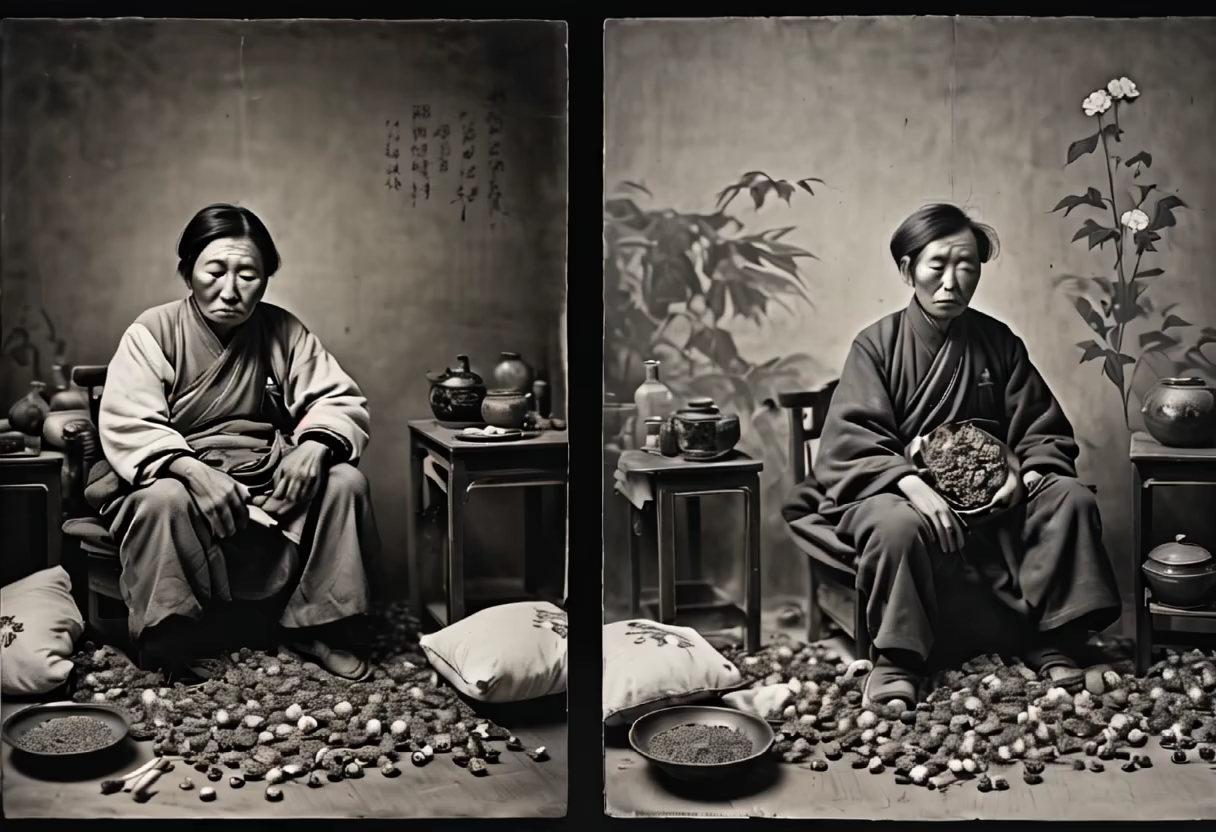
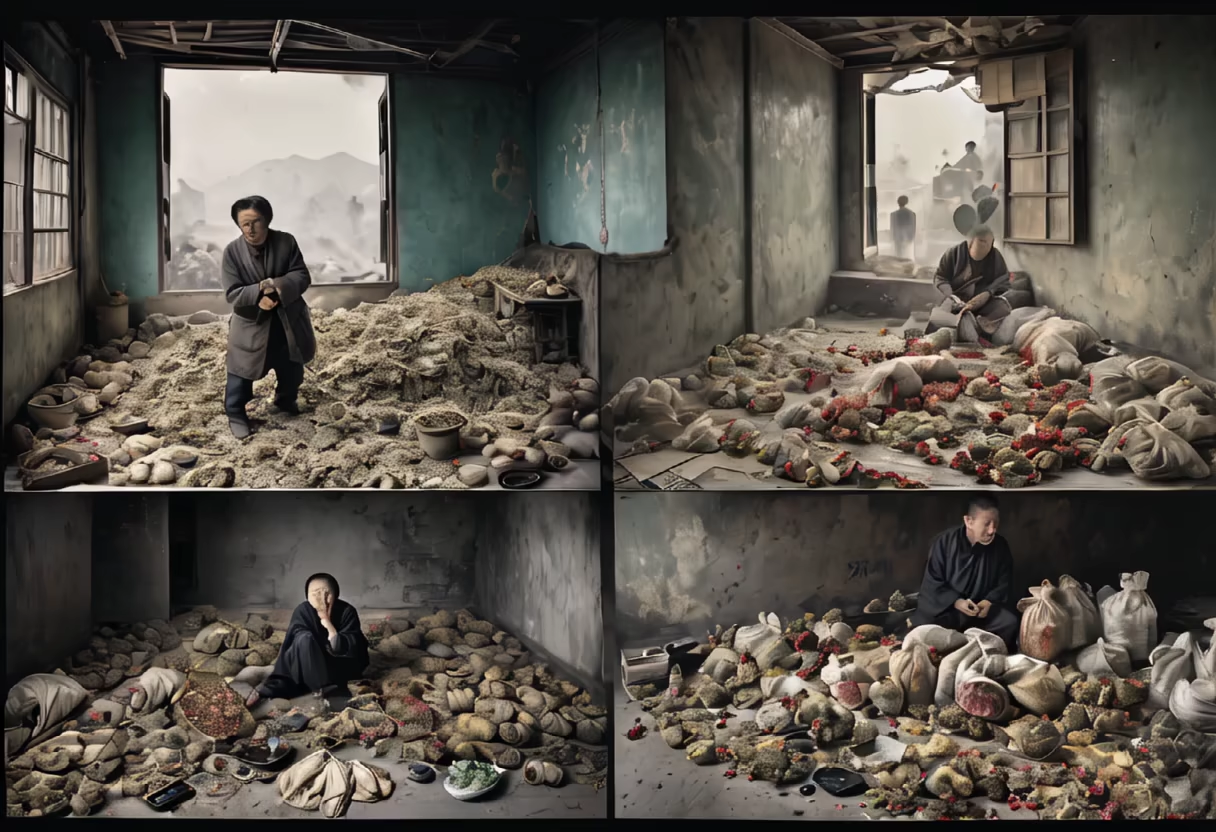
Prompt: The image depicts a stylized representation of a historical scene from the First Opium War. In the foreground, there are silhouettes of British and Chinese ships engaged in conflict, with billowing smoke from cannon fire. The British ships, appearing more modern and technologically advanced, loom prominently, while the Chinese vessels are depicted with a sense of struggle and vulnerability. Amidst the chaos, there are symbolic elements scattered around: broken treaties, opium crates, trade agreements, and people suffering in the background, hinting at the destructive aftermath of the conflict. The image aims to portray the clash between advanced weaponry, misguided trade policies, and the human cost of such conflicts, evoking a sense of turmoil and consequence.
Style: Photographic
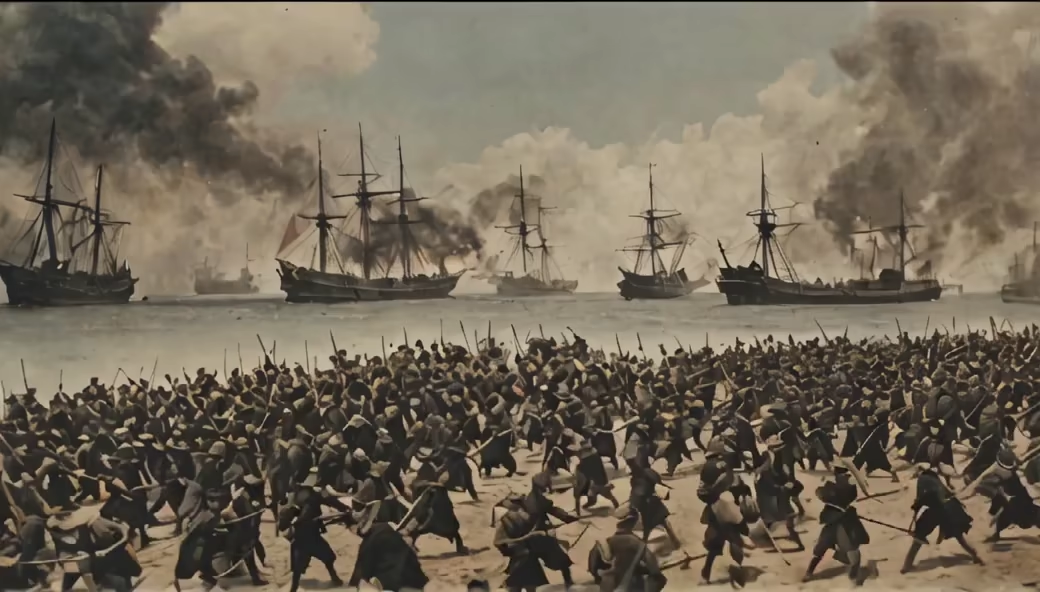
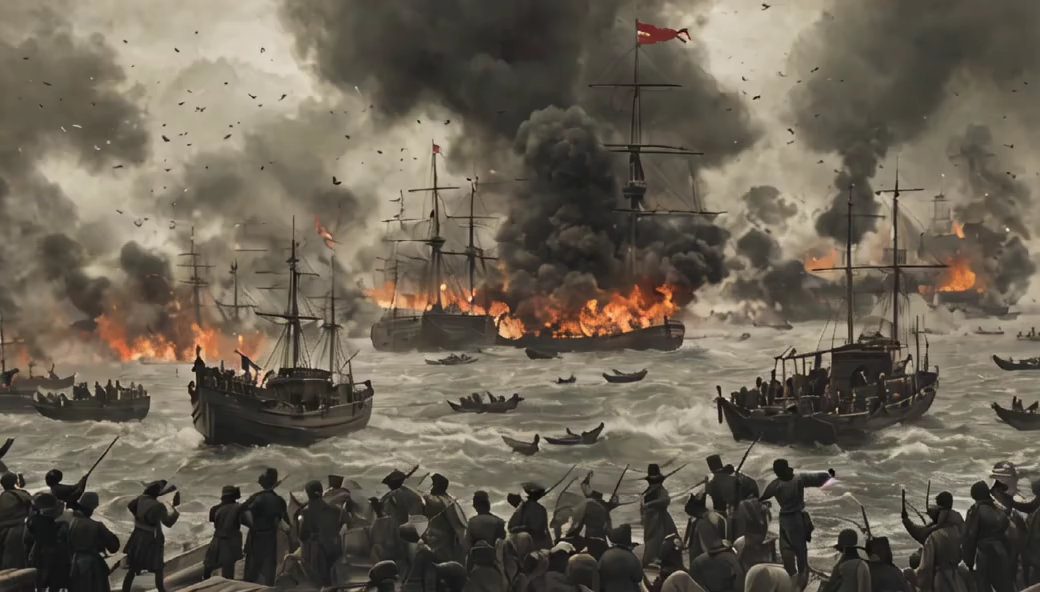
Prompt: The image portrays a series of pivotal naval battles during the Opium Wars, highlighting the overwhelming display of British naval power and the intensity of the conflicts. In the foreground, a British naval squadron takes center stage, their warships positioned with precision in battle formation. These imposing vessels, marked with the Union Jack, loom large over the waters, emitting billows of smoke and fire from their cannons. In contrast, Chinese junks and naval vessels, depicted in the background, attempt to resist the formidable British onslaught. The Chinese ships, although numerous, appear outnumbered and outmatched, struggling against the relentless barrage of firepower from the British fleet. The tumultuous sea is the focal point, churned by the exchange of cannon fire and the chaos of battle. The sky overhead is overcast, mirroring the tension and gravity of the confrontations at Tamao, Chuanbi, and Bogue. This vivid depiction captures the decisive moments of these historic battles, illustrating the overwhelming dominance of the British forces in terms of naval firepower and strategy, shaping the outcome of the conflicts during the Opium Wars.
Style: Cinematic
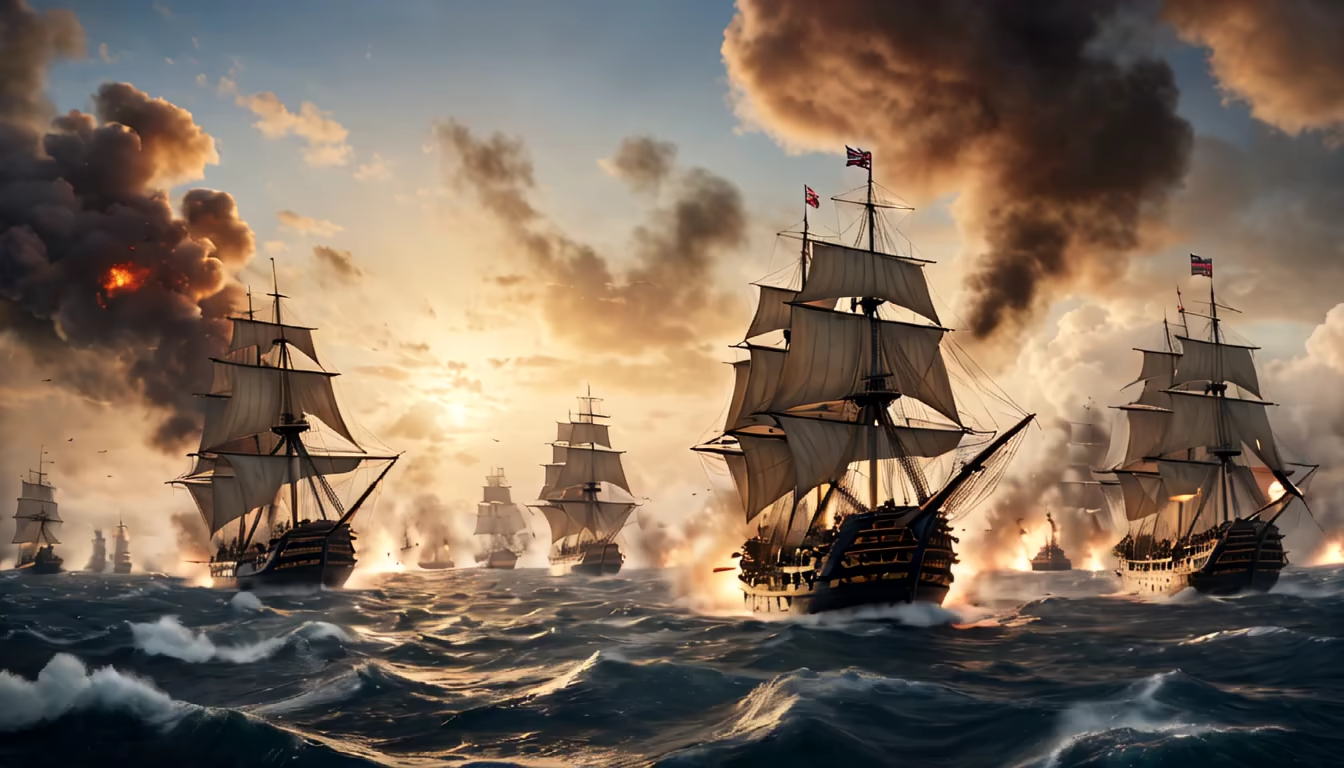
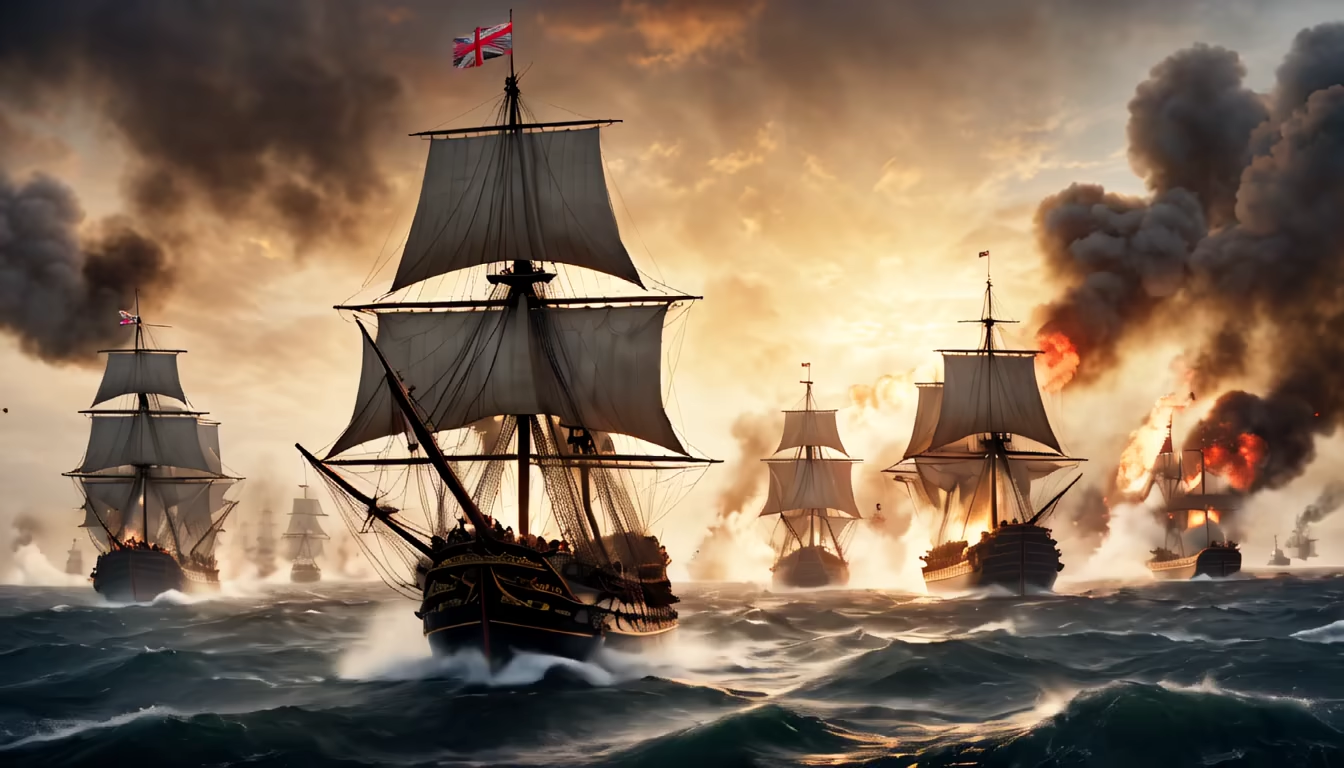
Prompt: \"In the face of refusal, the British, staunch in their stance, demanded recompense for the lost opium and the preservation of trade. Upon encountering resistance, their formidable naval forces embarked on a determined course toward the shores of China, signaling an impending clash of powers.\"
Style: Photographic
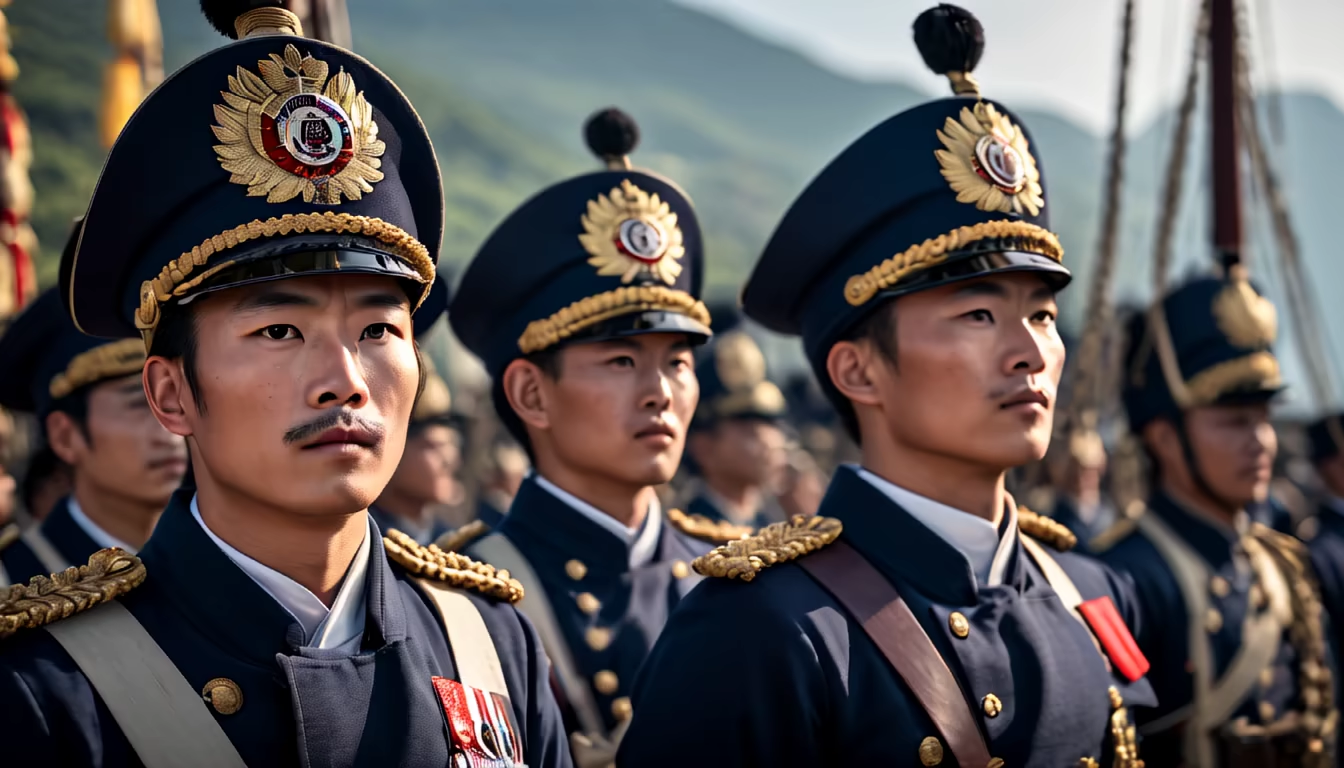
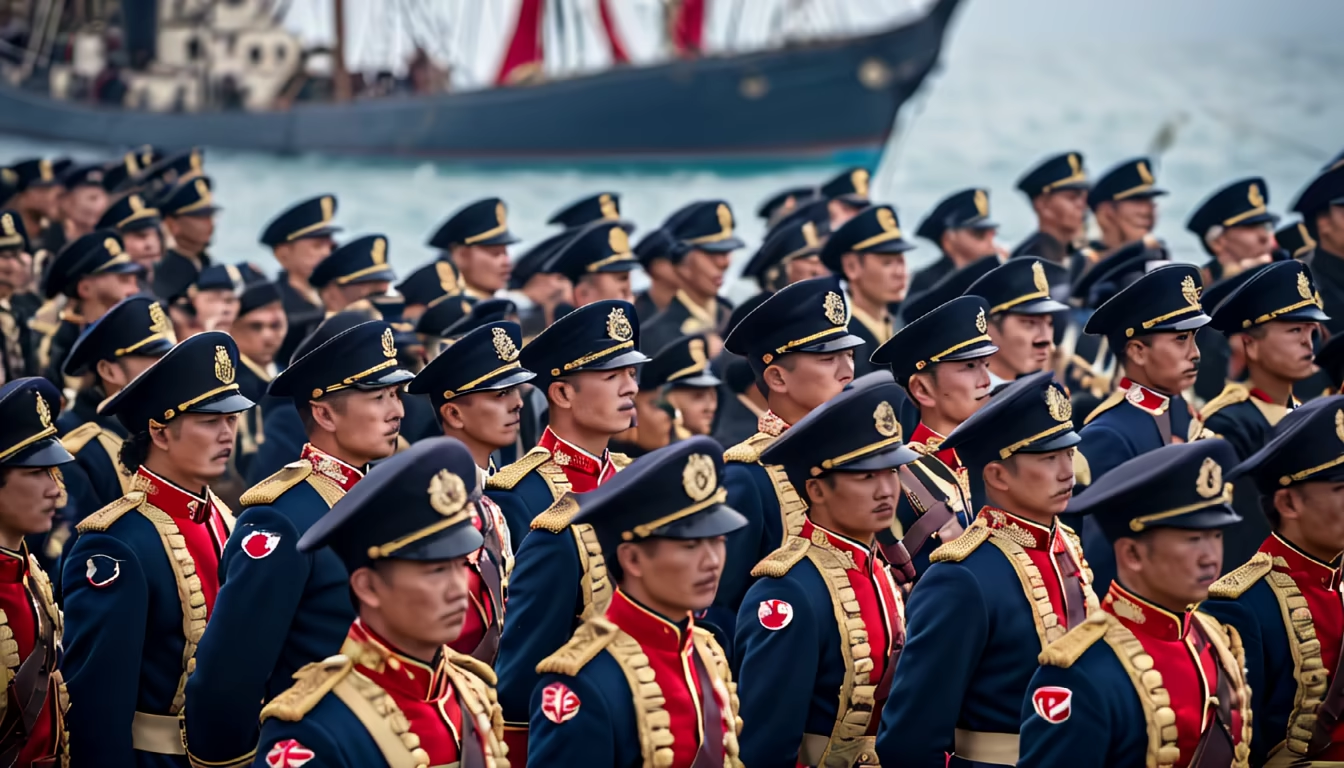
Prompt: \"Generate an immersive portrayal illustrating the shift caused by the treaty's requirement to open five treaty ports—Canton, Amoy, Foochow-fu, Ningpo, and Shanghai—showcasing the dissolution of China's former imperial control over foreign commerce and the ensuing influx of British trade and residency within these ports.\"
Style: Cinematic
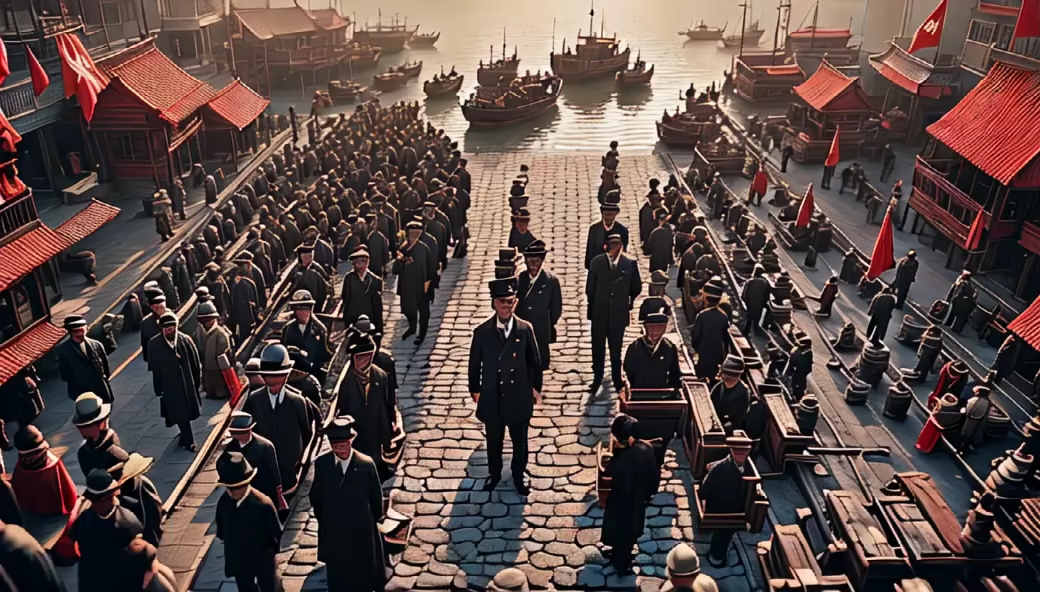
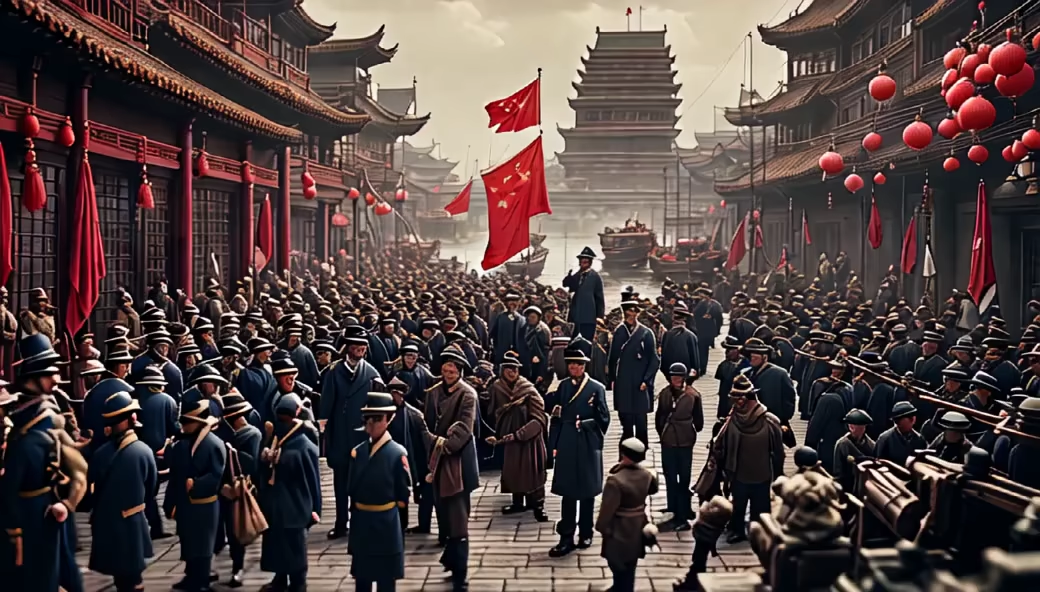
Prompt: Visualize the concept of extraterritoriality with two scales - one side representing British law and the other Chinese law, with a British citizen standing elevated on the British law side, symbolizing the legal superiority granted by the treaty. ancient background .ancient british \u0026 chinese people should be shown . two pictures should be shown in one frame depicting the situation .
Style: Cinematic

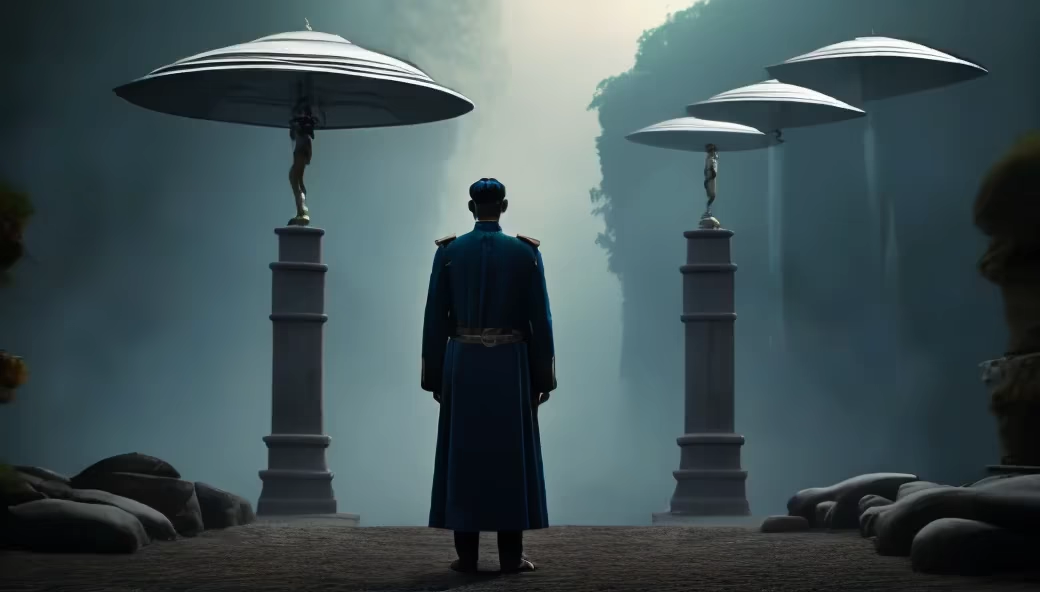
Prompt: Era: Han Dynasty architecture. Architecture: A ancient city situated on the left side of the scene. The city walls are tall, surrounded by moats, and guarded by city gates and protective walls. Battlefield: Located on the right side of the scene, filled with scenes of intense warfare. Warriors are engaged in fierce combat, with flashing swords and blood splattering. Warfire: The city is surrounded by raging fires, with black smoke billowing. The flames illuminate the sky, casting a glow over the entire battlefield. Snowy mountains: Behind the city lies a series of snow-capped mountains, reaching high into the clouds. The mountain peaks are covered in pure white snow, resembling a majestic barrier when viewed from a distance.
Style: Photographic




Prompt: Campaign banners cross Han border seas, homeward geese wing heavenwards in realms of Huns, minimal tones convey flowing of seasons and fates, subtle textures hold implications of lives through transient states, atmospheres inspire care for ties across disputing domains, cultural roots nurture knowing kin through superficial dissent, 8K brings in fleeting scenes intimations of deeper bonds, lighting unveils depths where casual eyes see surface throngs, wandered perception gleans messages in unrest between calm
Style: Photographic


Prompt: The image depicts a stylized representation of a historical scene from the First Opium War. In the foreground, there are silhouettes of British and Chinese ships engaged in conflict, with billowing smoke from cannon fire. The British ships, appearing more modern and technologically advanced, loom prominently, while the Chinese vessels are depicted with a sense of struggle and vulnerability. Amidst the chaos, there are symbolic elements scattered around: broken treaties, opium crates, trade agreements, and people suffering in the background, hinting at the destructive aftermath of the conflict. The image aims to portray the clash between advanced weaponry, misguided trade policies, and the human cost of such conflicts, evoking a sense of turmoil and consequence.
Style: Cinematic

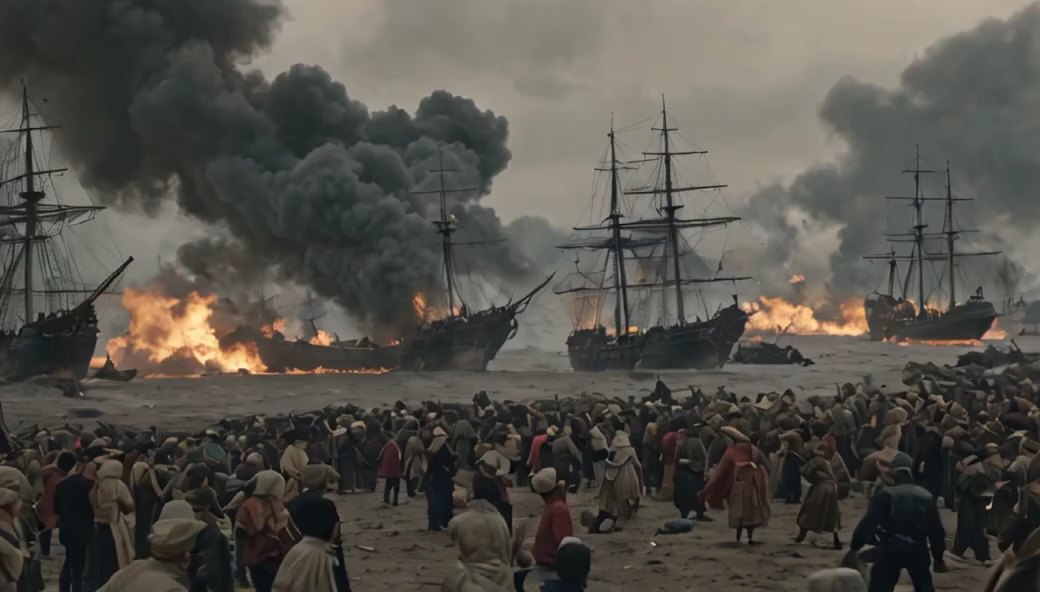
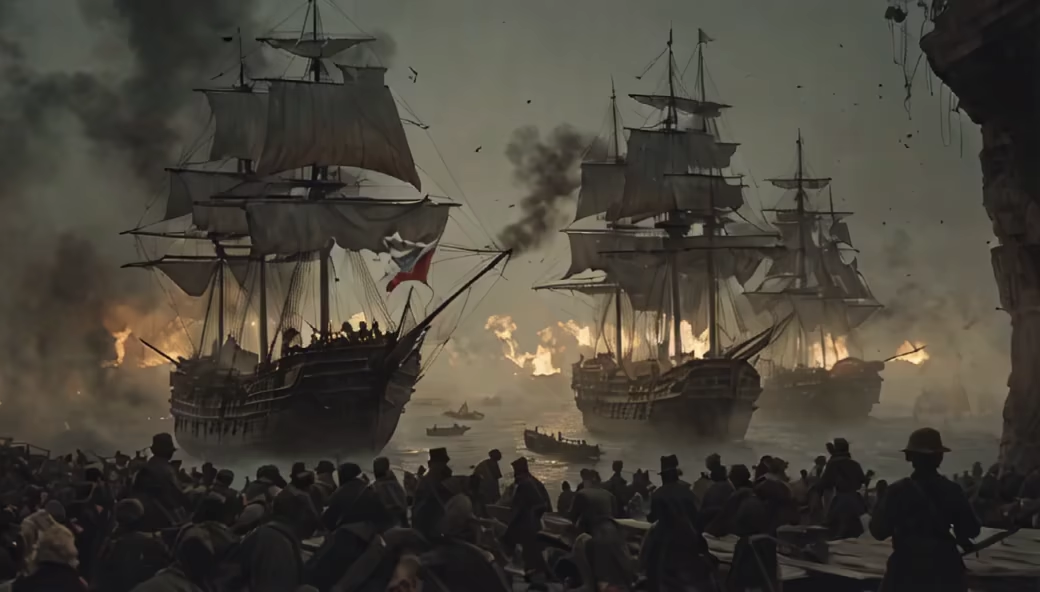
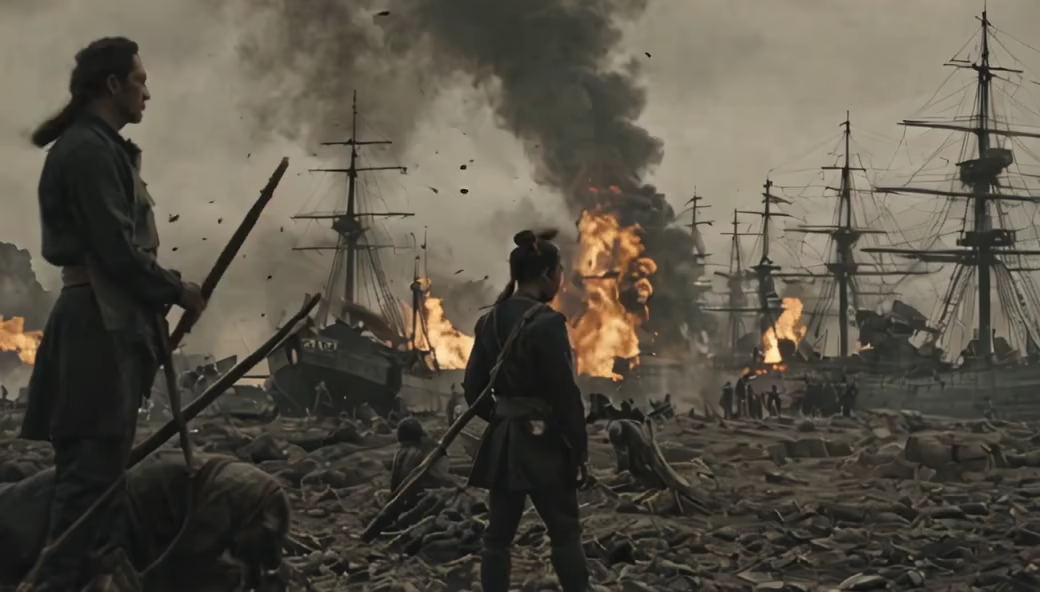
Prompt: How about an image showing a historical trade scenario between China and Britain? It could feature Chinese goods like tea, silk, and porcelain being loaded onto ships headed to Britain, while British goods or representatives struggle to gain entry into China, illustrating the one-sided nature of the trade relationship. This could be depicted through contrasting scenes or visuals to highlight the unequal exchange.
Style: Digital Art


Prompt: Paper pulp box handmade soap packaging, with independent packaging, containing handmade soap, white pulp color, design, pulp texture box, can be used as a soap box, unique and creative shape,
Negative: Too big, no sense of design


Prompt: Charles VII and Joan of Arc in 1429, a moment of unity and triumph, capturing the essence of their historical collaboration.
Negative: Combat suit armor
Style: Cinematic


Prompt: Imagine a scene depicting British naval ships surrounding the island of Hong Kong, showcasing their dominance over the strategic location. You could include British flags, ships at sea, and the silhouette of Hong Kong Island in the background to portray the historical moment of British control over the territory.
Style: Photographic
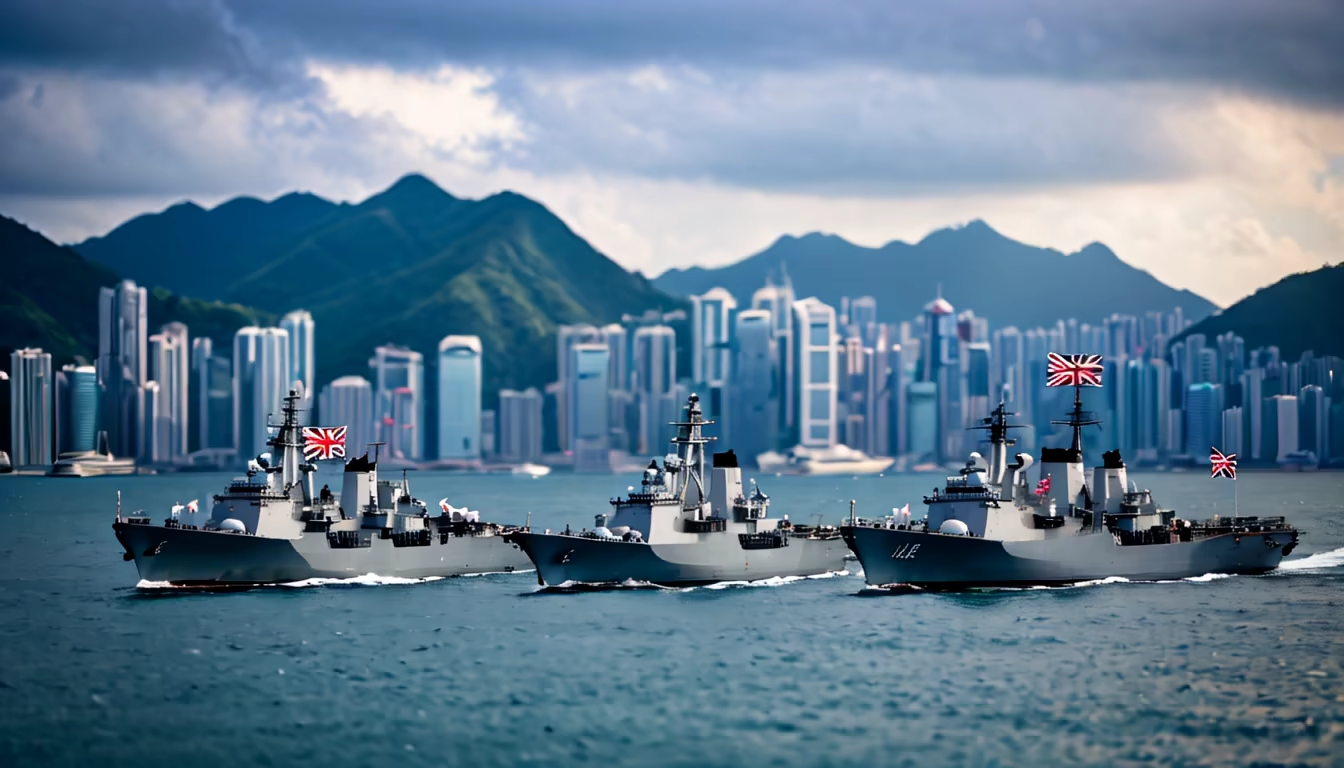
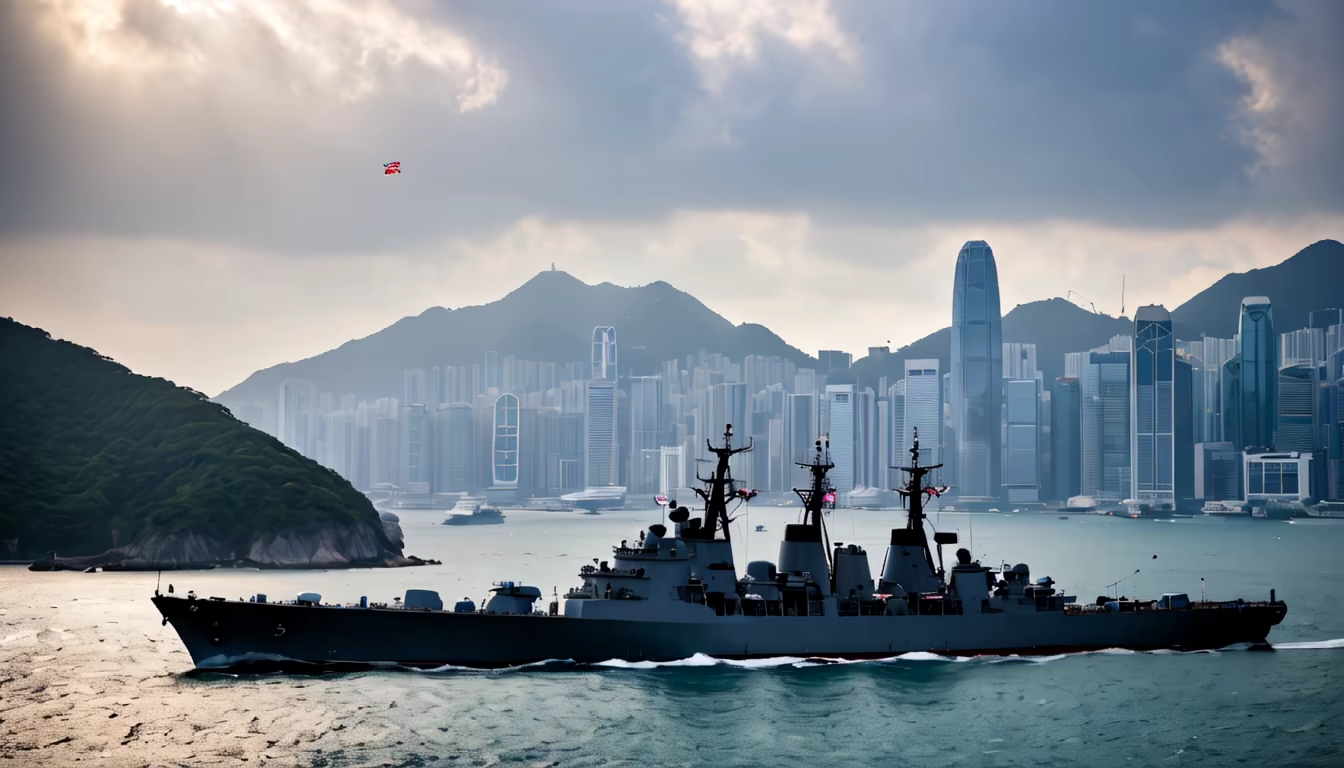
Prompt: Map depicting British ships surrounding the island of Hong Kong, showcasing their dominance over the strategic location. You could include British flags, ships at sea, and the silhouette of Hong Kong Island in the background to portray the historical moment of British control over the territory.
Style: Cinematic
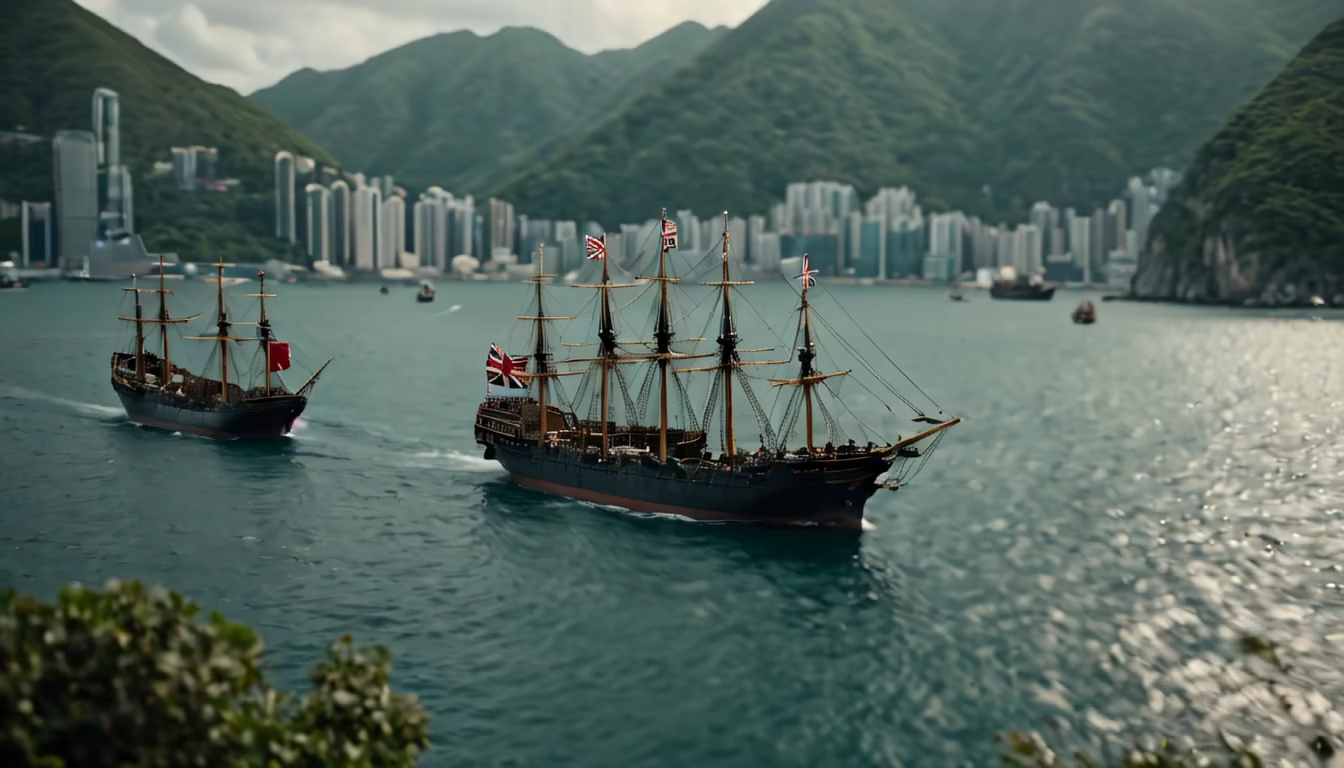
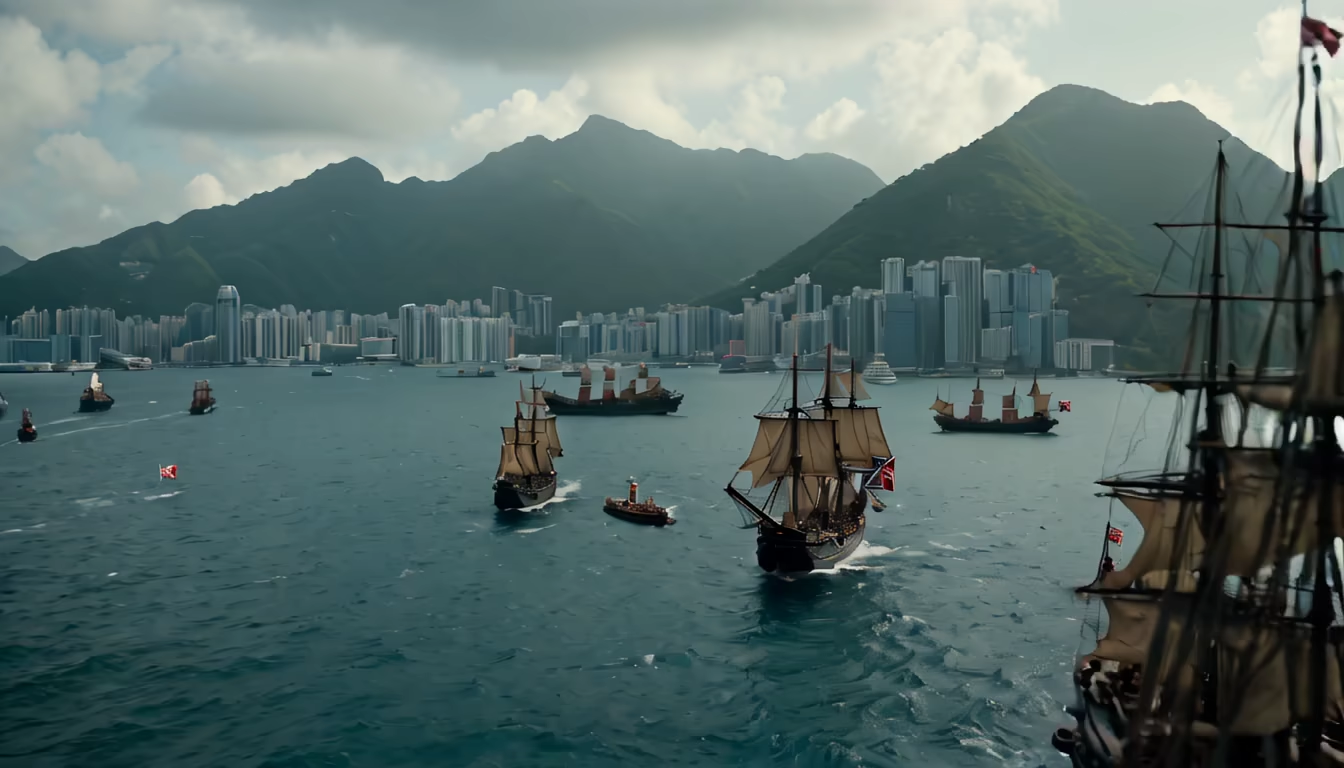
Prompt: Imagine a scene depicting British ships surrounding the island of Hong Kong, showcasing their dominance over the strategic location. You could include British flags, ships at sea, and the silhouette of Hong Kong Island in the background to portray the historical moment of British control over the territory.This happened during the Opium War.
Style: Cinematic

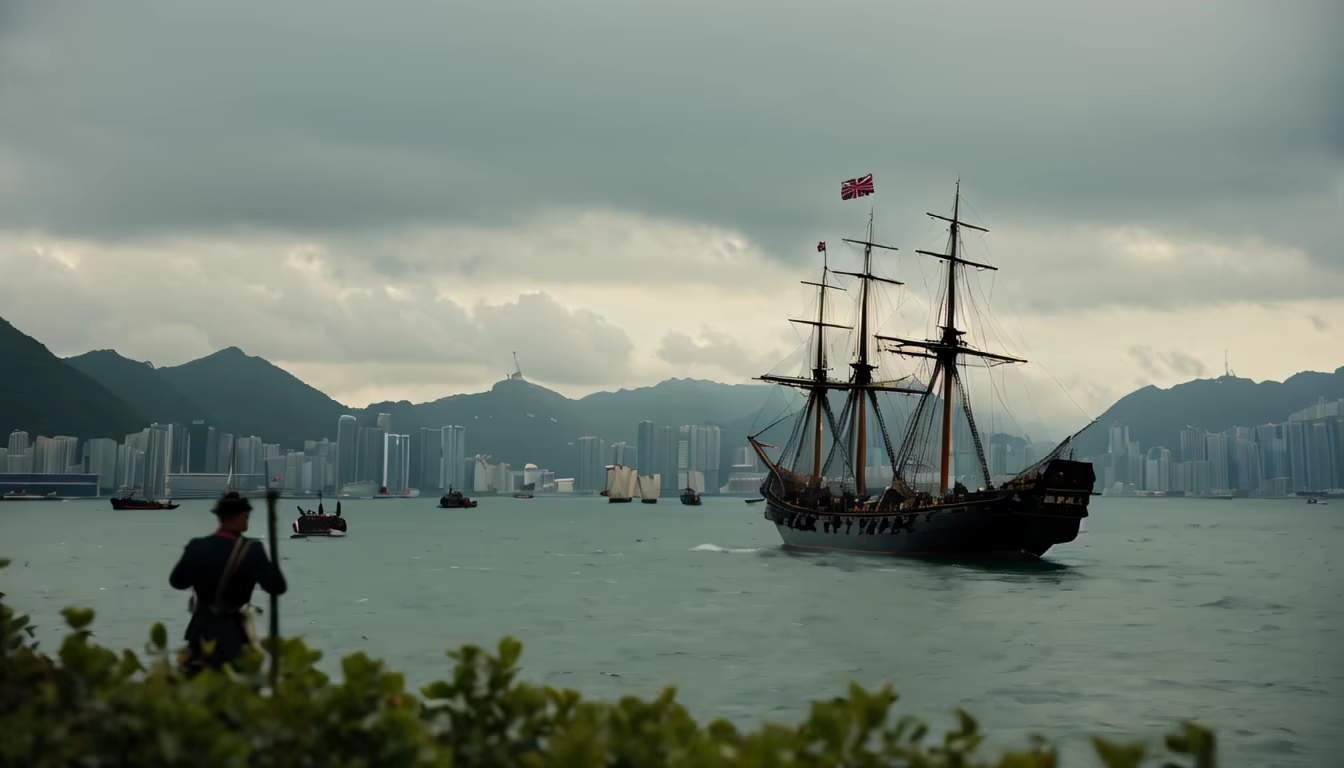
Prompt: The image depicts a tumultuous maritime scene dominated by a fleet of imposing British warships. These vessels, intricately detailed, loom large on the water, their sails billowing in the wind. They are arranged in a strategic formation, showcasing their formidable strength and advanced naval technology. In the background, the skyline is obscured by the smoke rising from continuous cannon fire. The British ships unleash a relentless barrage upon the coastline and Chinese defenses. Explosions and impacts from cannonballs are visible on the shore, indicating the intensity of the assault. In contrast, smaller Chinese ships and defenses are shown attempting to resist the overwhelming British offensive, but they appear dwarfed and outmatched by the superior firepower and organization of the British fleet. The image conveys a sense of overwhelming force, illustrating the unyielding and aggressive nature of the British military campaign during the First Opium War. It highlights the power imbalance and the relentless onslaught that the Chinese forces faced against the technologically superior and determined British navy.
Style: Photographic
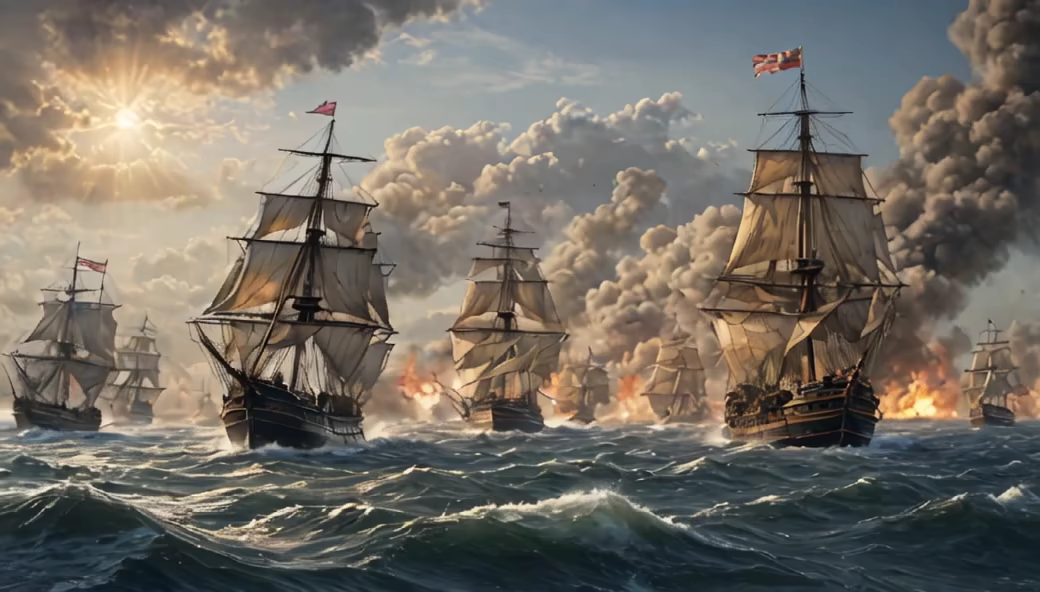
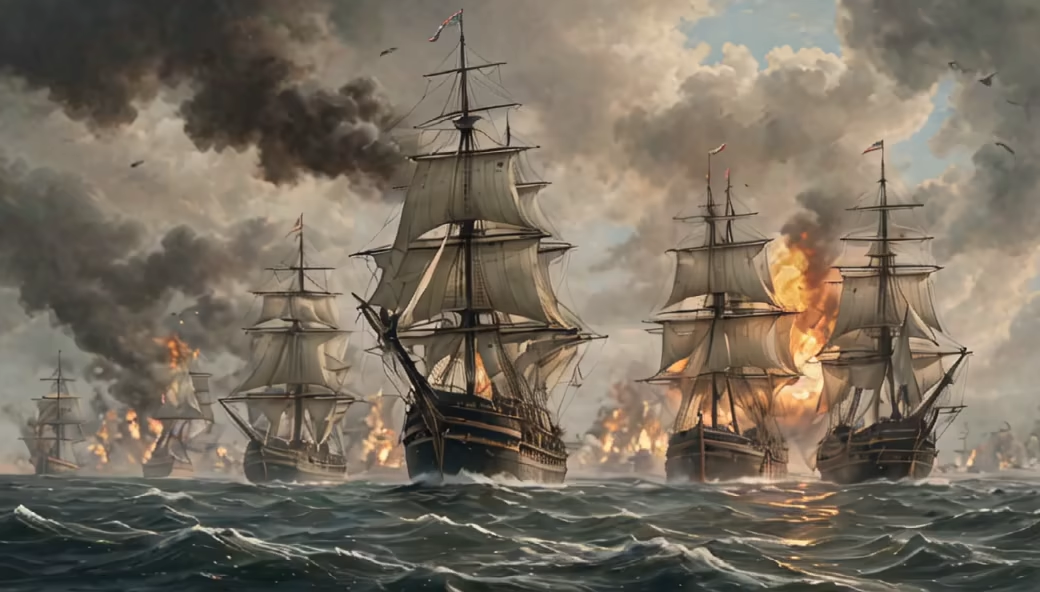
Prompt: In this striking image, a powerful British naval fleet dominates the horizon, sailing forth with purpose towards the coast of China. The sea stretches vast and deep, reflecting the golden hues of the setting sun. The fleet consists of imposing warships, their sails billowing in the wind, their hulls lined with cannons and flags bearing the Union Jack. On the distant shoreline, the silhouette of the Chinese coast emerges, its contours hinting at rocky cliffs and traditional pagoda-style structures nestled among lush greenery. Along the coast, a bustling port town with ancient architecture stands as a stark contrast to the approaching modern British naval power. The atmosphere is charged with tension and anticipation, capturing the pivotal moment when diplomatic negotiations faltered, and the British navy embarked on its journey towards the Chinese coast in response to the refusal of their demands. The image conveys the looming threat of conflict and the clash of technological, military, and diplomatic powers between the British Empire and China during this historical period.
Style: Cinematic
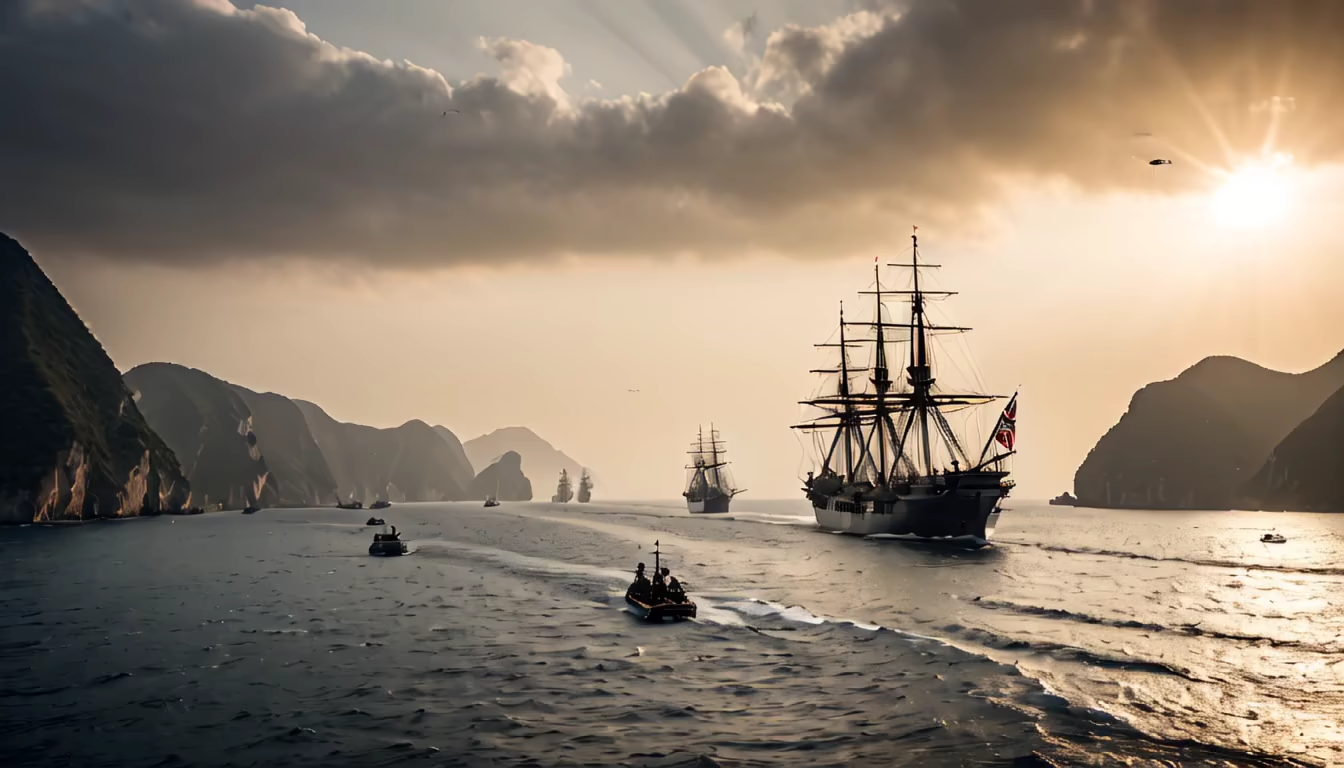
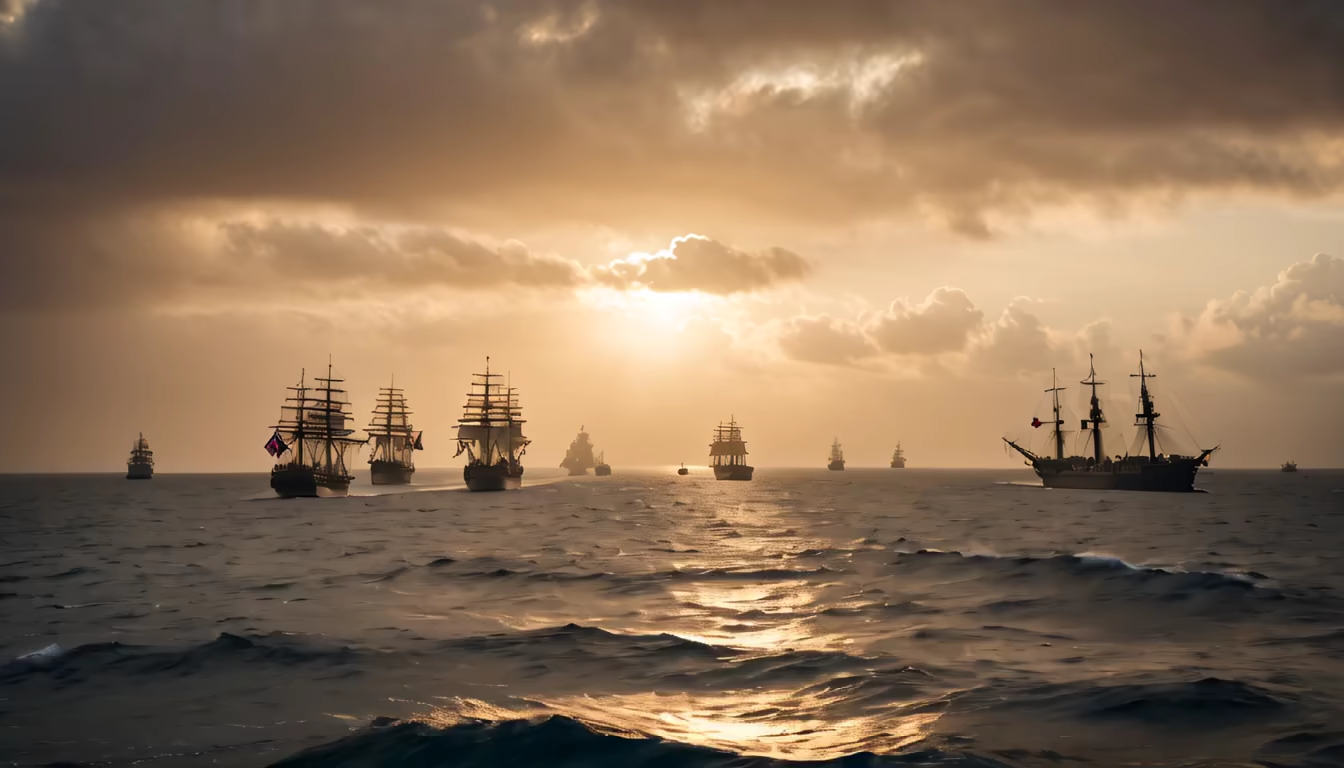
Prompt: Generate an image showing the strategic significance of China as a gateway for the British Empire to access the vast markets of the Far East, symbolizing its importance.
Style: Digital Art
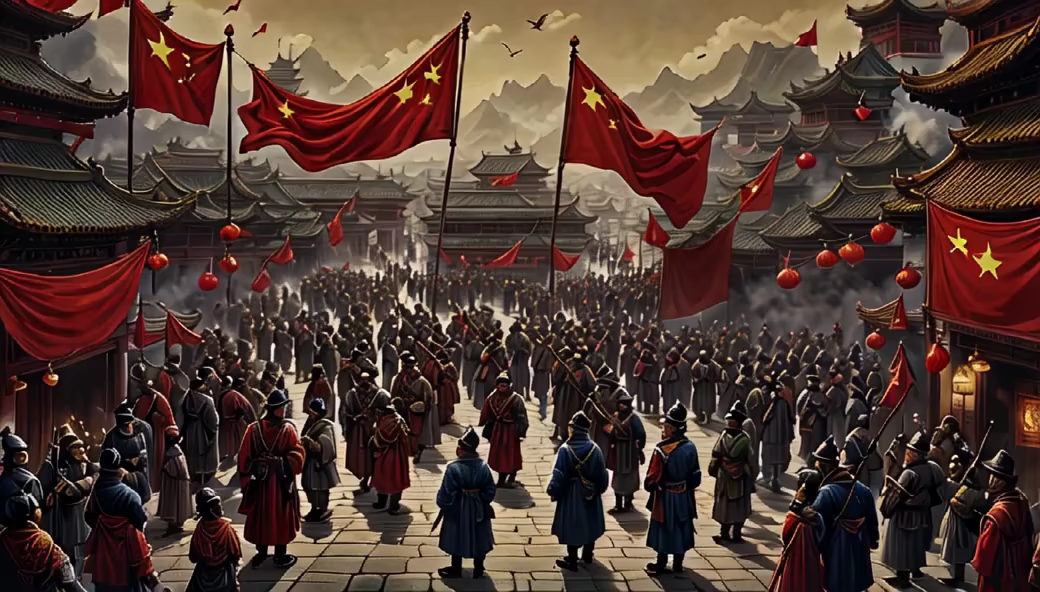
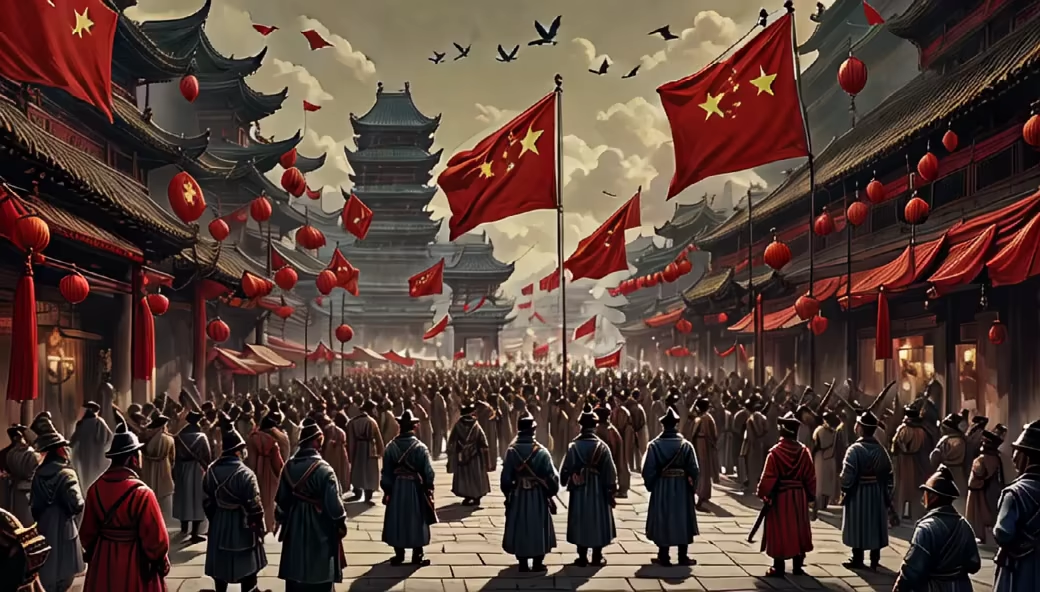
Prompt: Demonstrate the creative design pattern, the details of the technology elements incorporated in the pattern, such as line flow, light and shadow changes (China's \"One Belt, One Road\" initiative). Clean and delicate clear and transparent image, dynamic and exciting, rich in details, visual spectacle, creative composition, colorful, delicate animation, visual feast, professional film lighting, Hollywood record film sense, 8K, --q 5 -s 5 --gs 20 -fps 30 -motion 10 Translated with www.DeepL.com/Translator (free version)
Style: Photographic


Prompt: Parallel shooting, the aircraft carrier and accompanying ships traveling together, showing the majestic scene of formation sailing. Clean image with rich details, professional movie lighting, HD movie documentary, techno-cinematic feel, Canon camera, lens, 8K, --ar 21:9 --q 5 -s 5 --gs 20 -fps 30 -motion 10
Style: Photographic

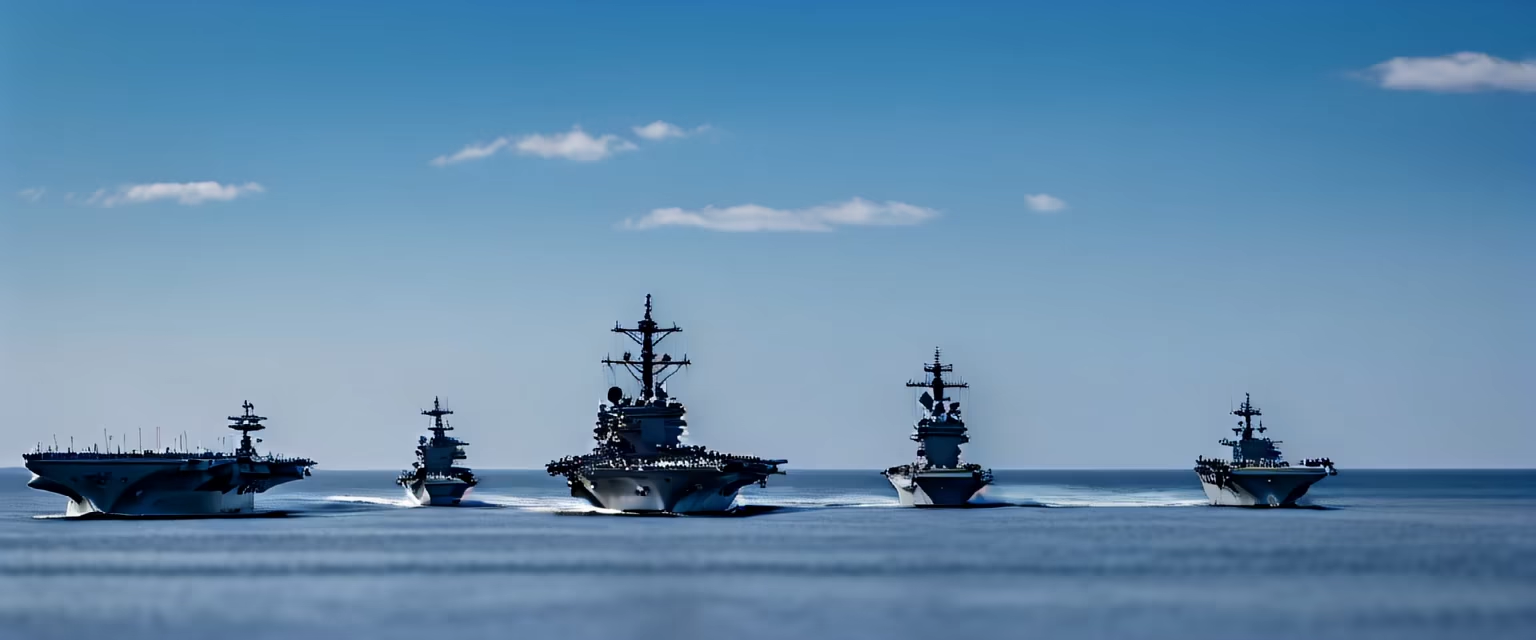
Prompt: A vivid, bustling scene depicting the vibrant landscape of Guangdong Province in the 19th century. The image captures the essence of the province, showcasing a bustling harbor teeming with numerous ships from various nations, their sails billowing in the breeze. On the docks, a fusion of cultures is evident as merchants from China and Western countries engage in animated discussions and trade activities. Amidst the commotion, opium chests are being unloaded from a British ship, flanked by Chinese officials and traders engaged in heated discussions. In the background, traditional Chinese architecture dots the landscape, juxtaposed against the imposing presence of Western-style buildings, symbolizing the clash of cultures and interests. Smoke wafts from opium dens nestled along narrow alleys, hinting at the pervasive influence of the opium trade within the province. The atmosphere is a blend of dynamism and tension, portraying the complex interactions, conflicts, and power struggles that characterized Guangdong Province as the epicenter of the opium trade during this era.
Style: Photographic
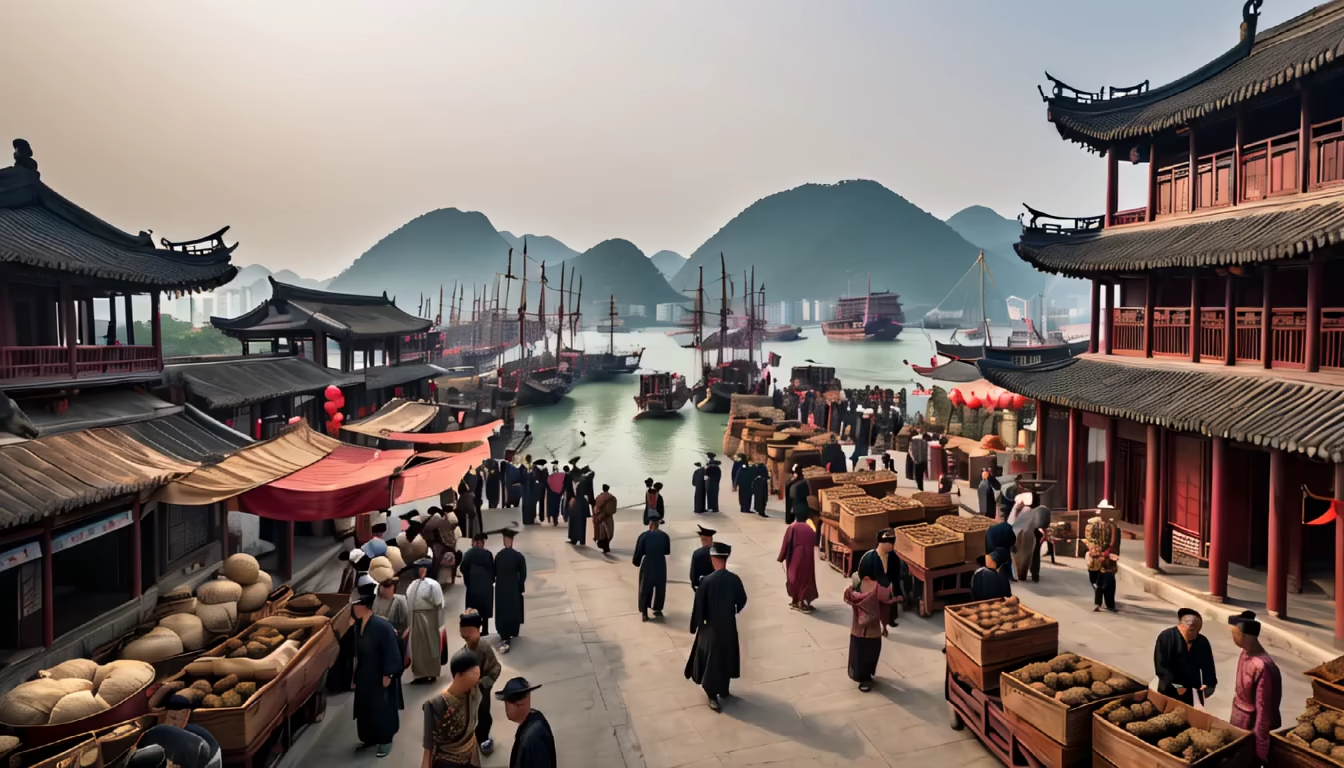
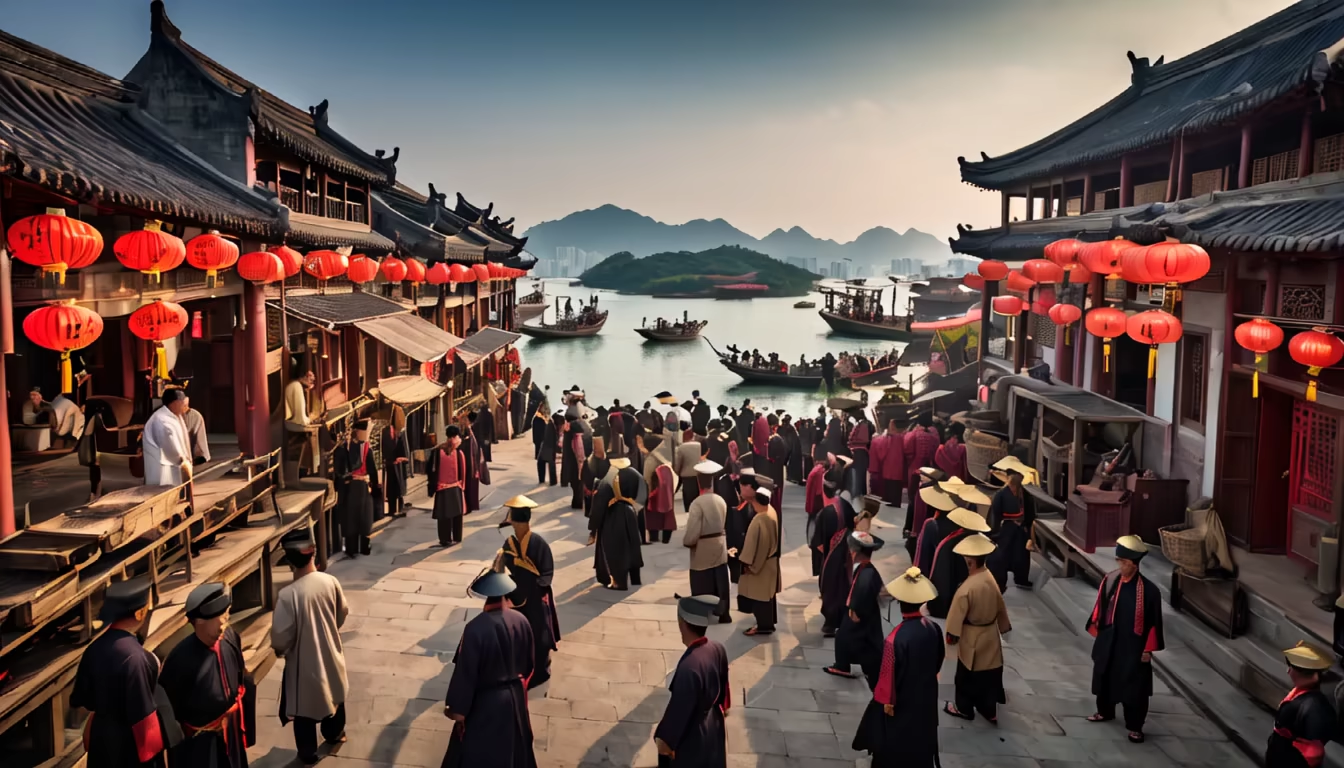
Prompt: The image portrays a dramatic scene set in the Nanjing Harbor in 1842. On one side of the image, there's a British warship dominating the scene, its imposing presence symbolizing power and authority. A group of British officials or diplomats stands on the deck, confidently negotiating terms. On the other side, Chinese officials, dressed in traditional attire, stand on a smaller boat or the harbor's edge, looking somber and outnumbered. They hold scrolls or documents, signifying the treaty. The mood is one of coercion and imbalance, capturing the unequal terms imposed on the defeated Chinese, highlighting the stark contrast in power dynamics between the two sides. The backdrop could feature the hazy silhouette of Nanjing, emphasizing the historical significance of the location.
Style: Fantasy Art
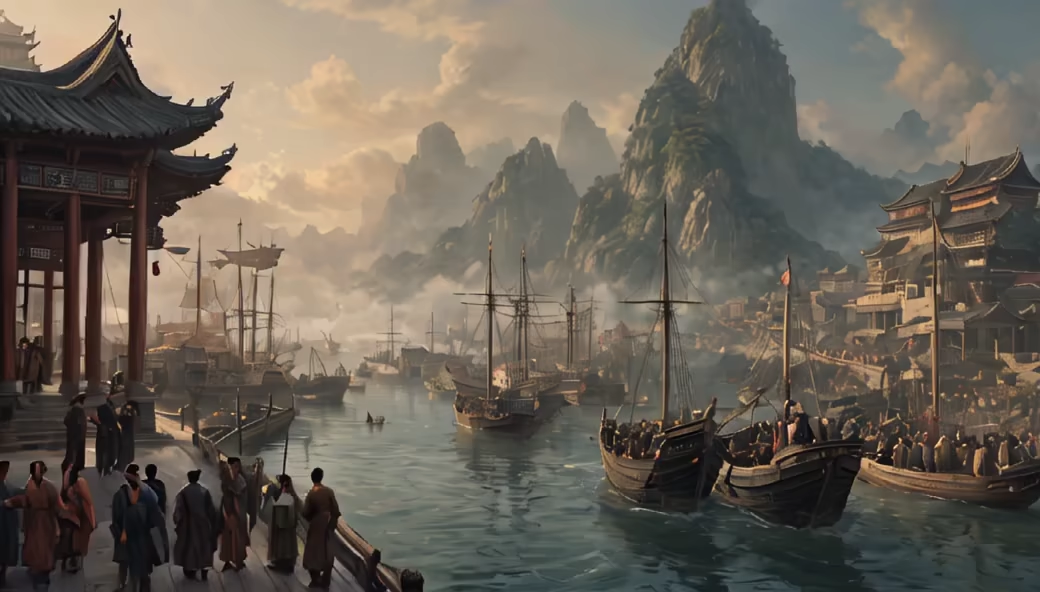

Prompt: Great Britain World War Ships On Sea With British Flag, Satellite view, Realistic
Style: Photographic


Prompt: Envision the Battle of Noryang, taking place on December 16, 1598, where the joint Korean and Ming naval forces achieved a decisive victory over the Japanese navy. Picture the tumultuous sea as the allied forces, led by Admiral Yi Sun-sin, skillfully outmaneuver and overpower the Japanese fleet. The scene is one of strategic brilliance and naval mastery, symbolizing the turning tide in favor of the Joseon-Ming alliance.
Style: Cinematic


Prompt: Envision the Battle of Noryang, taking place on December 16, 1598, where the joint Korean and Ming naval forces achieved a decisive victory over the Japanese navy. Picture the tumultuous sea as the allied forces, led by Admiral Yi Sun-sin, skillfully outmaneuver and overpower the Japanese fleet. The scene is one of strategic brilliance and naval mastery, symbolizing the turning tide in favor of the Joseon-Ming alliance.
Style: Cinematic
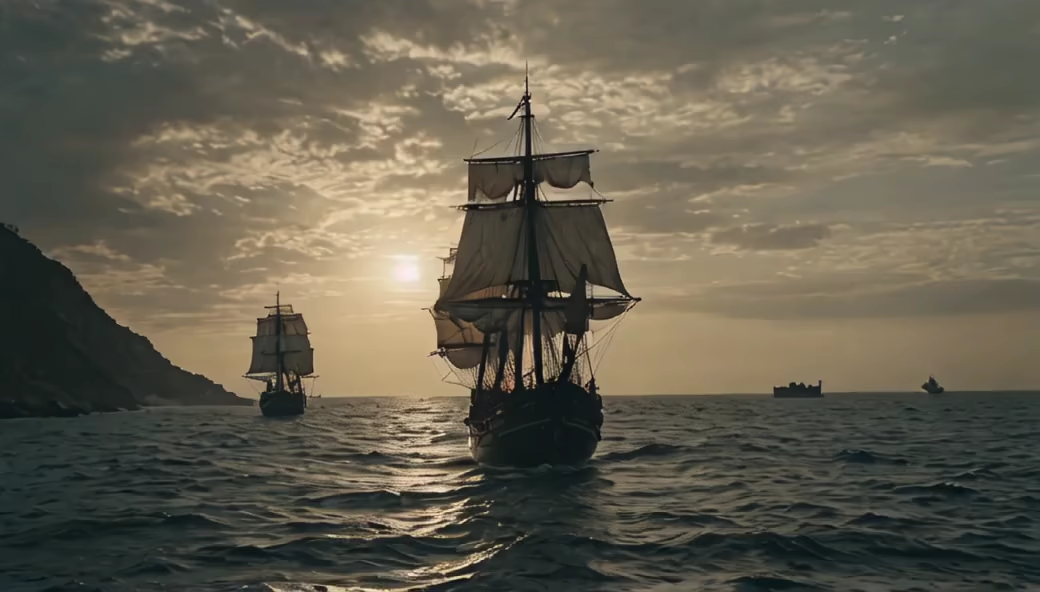
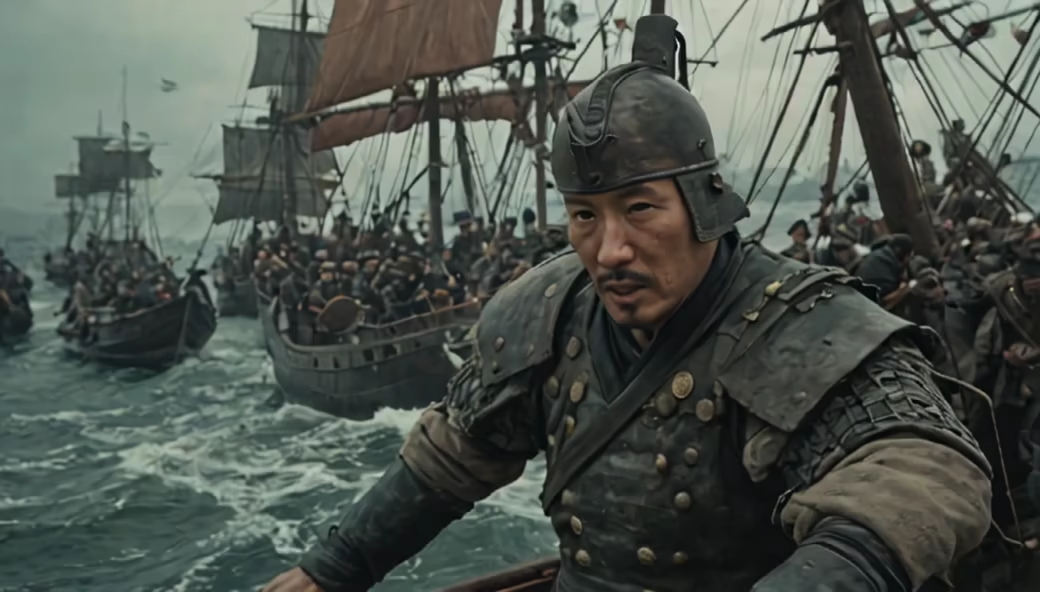
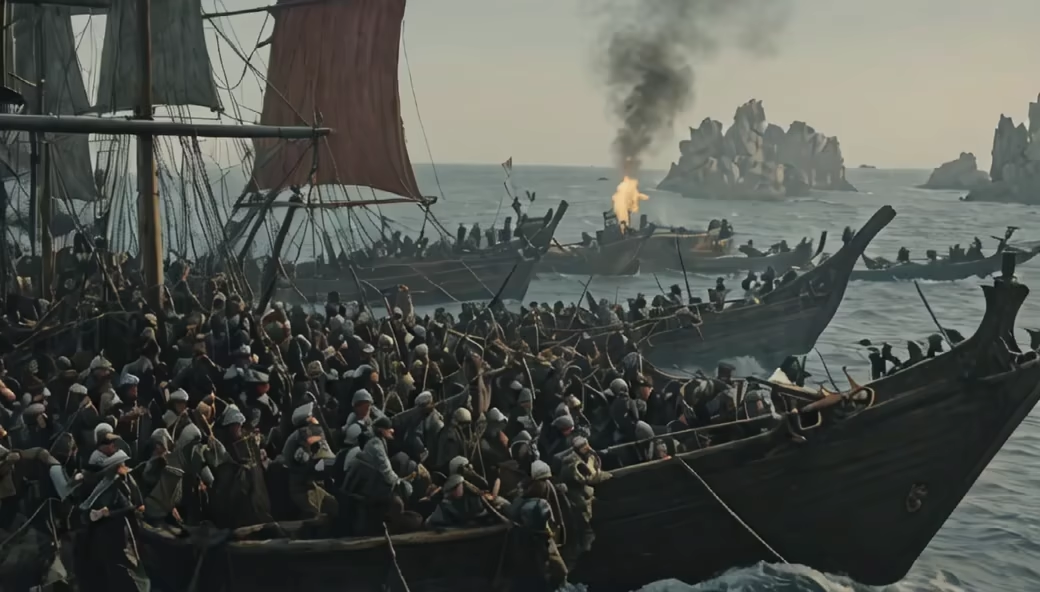
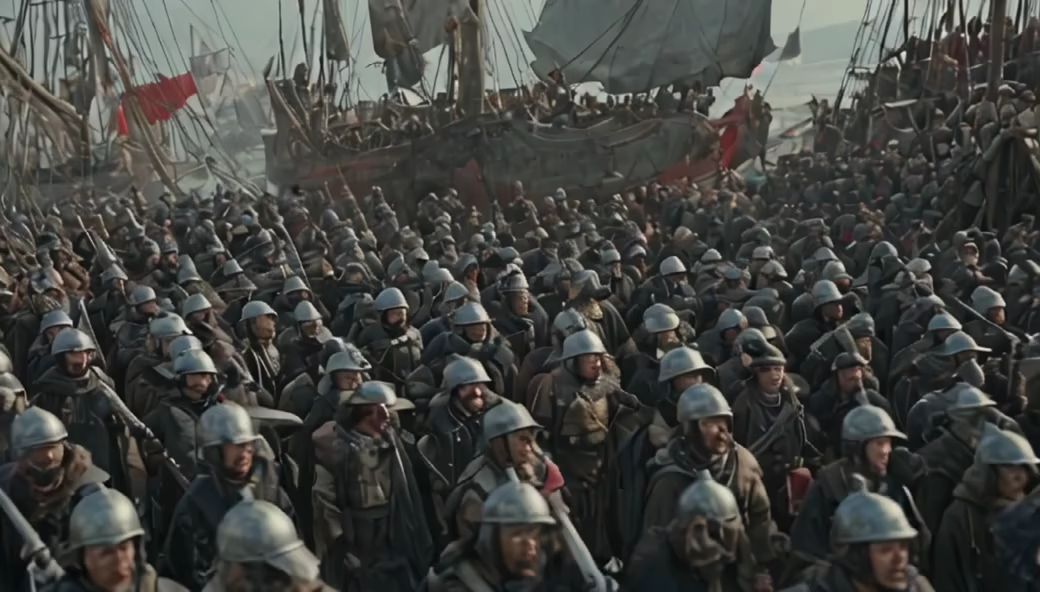
Prompt: You can visualize a collage of iconic German museums with recognizable elements, such as the Pergamon Museum's breathtaking Ishtar Gate, the Altes Museum's elegant neoclassical facade, and the Städel Museum's modern glass extension. The image can also include a mix of art pieces from various periods, symbolizing the rich cultural heritage and artistic diversity found within these museums.
Style: Photographic


Prompt: Generate an evocative visual representation depicting the enforced opening of the five treaty ports - Canton, Amoy, Foochow-fu, Ningpo, and Shanghai - showcasing the significant shift from the prior imperial control over foreign commerce to the initiation of British trade and habitation within these ports as mandated by the treaty.
Style: Cinematic

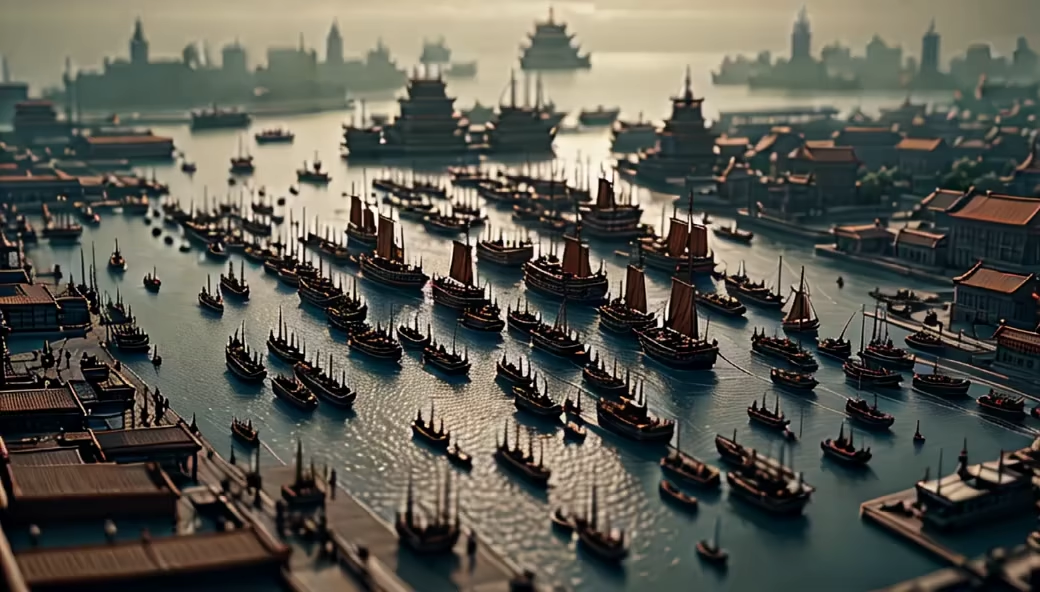
Prompt: Imagine a map depicting British ships surrounding the island of Hong Kong, showcasing their dominance over the strategic location.
Style: Photographic



